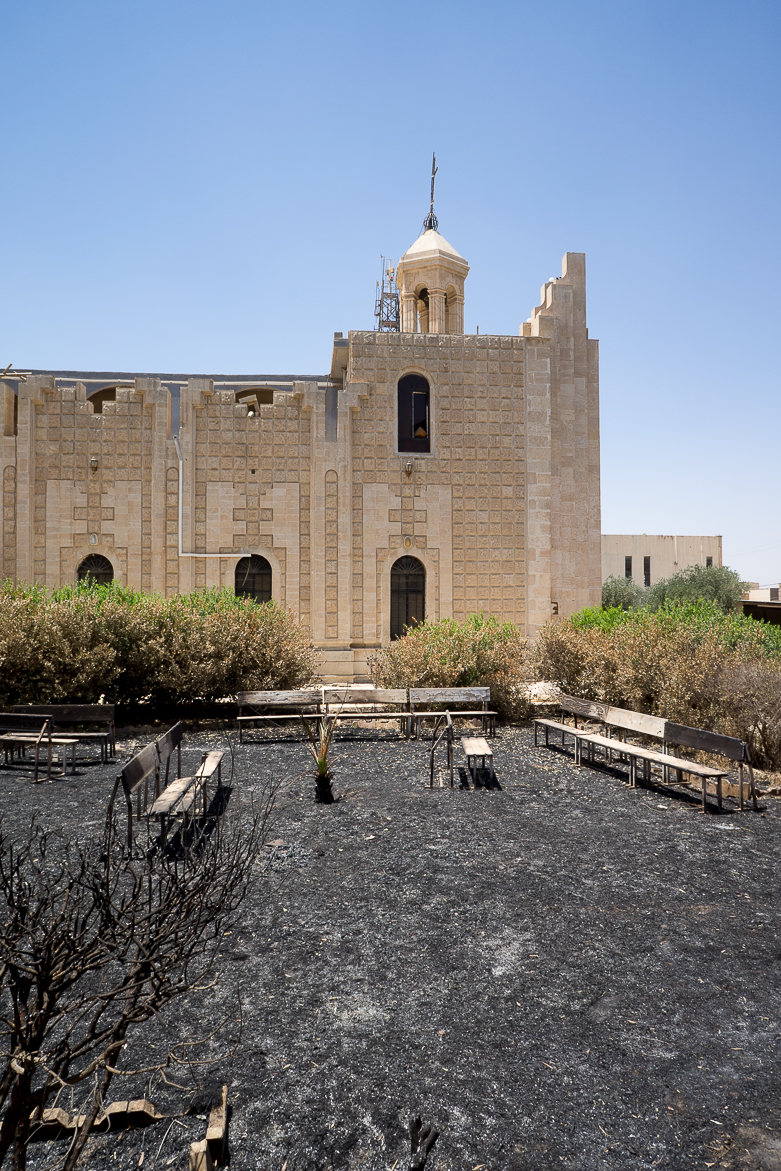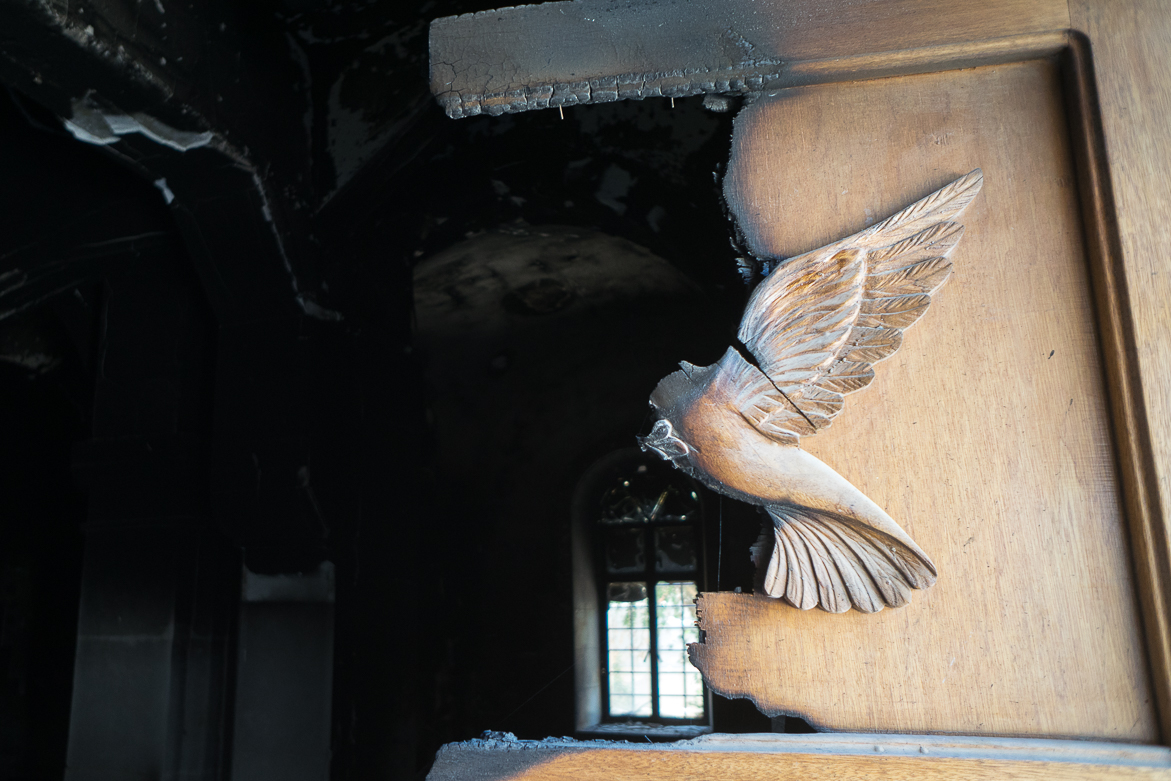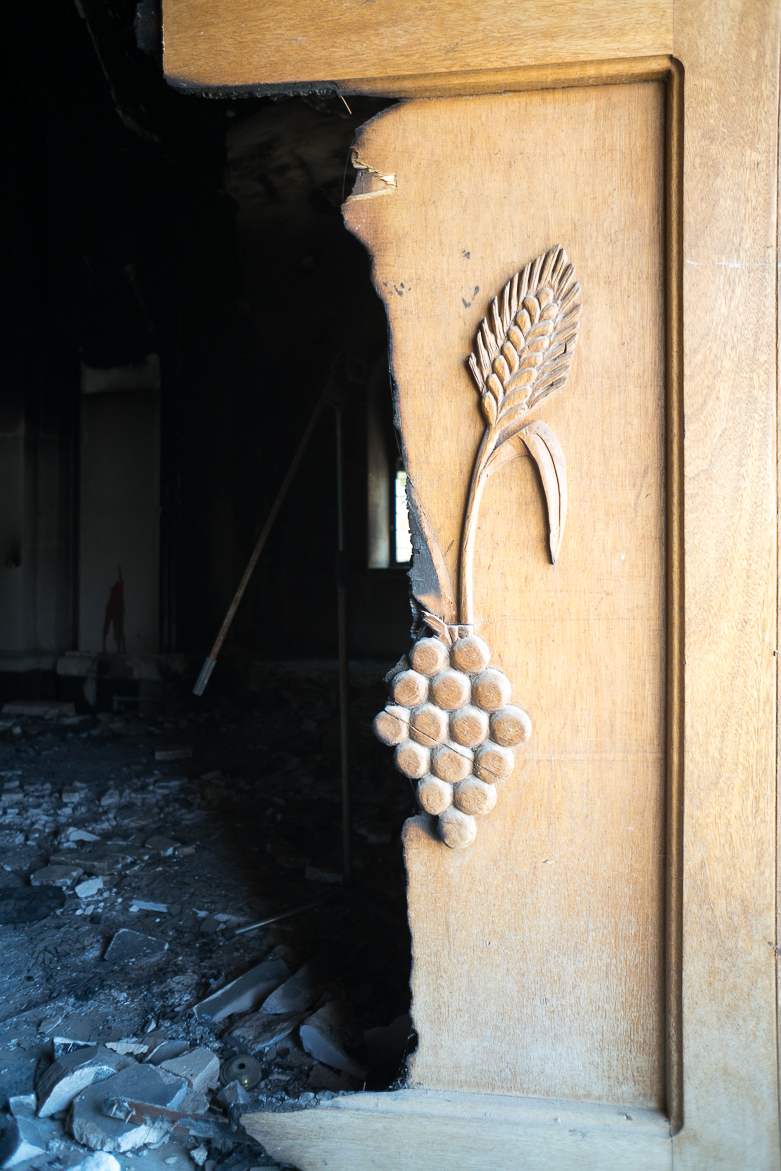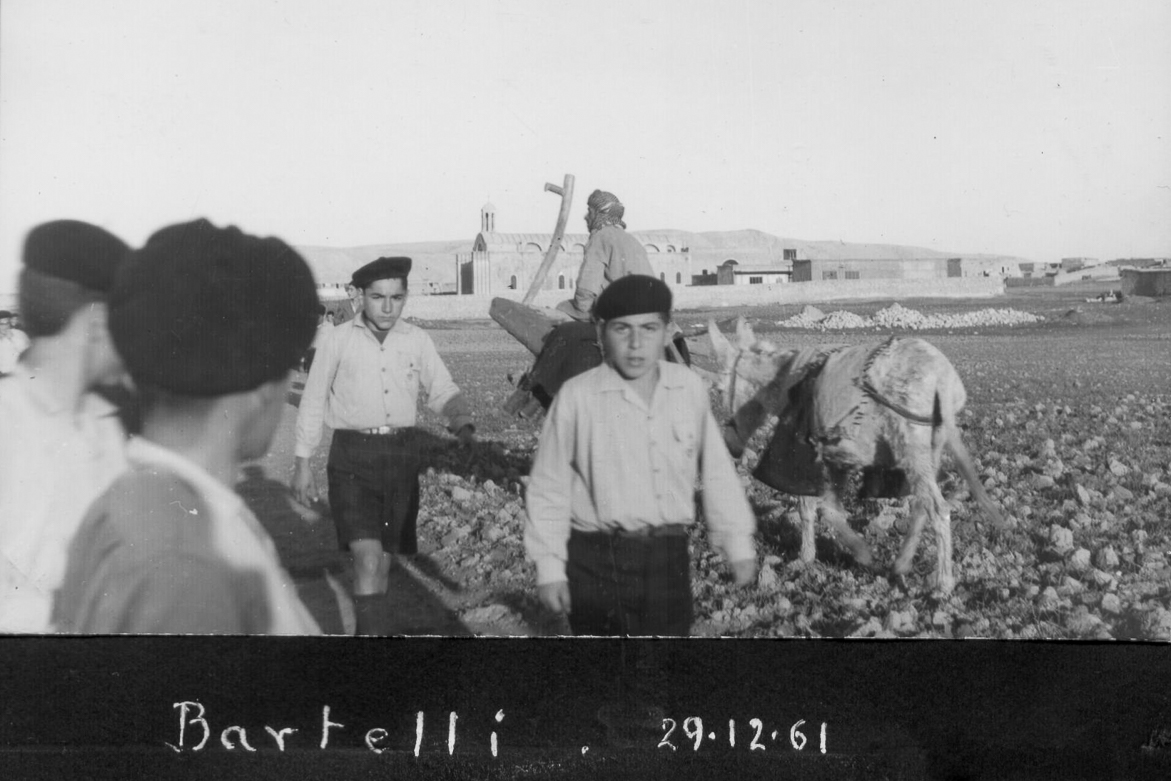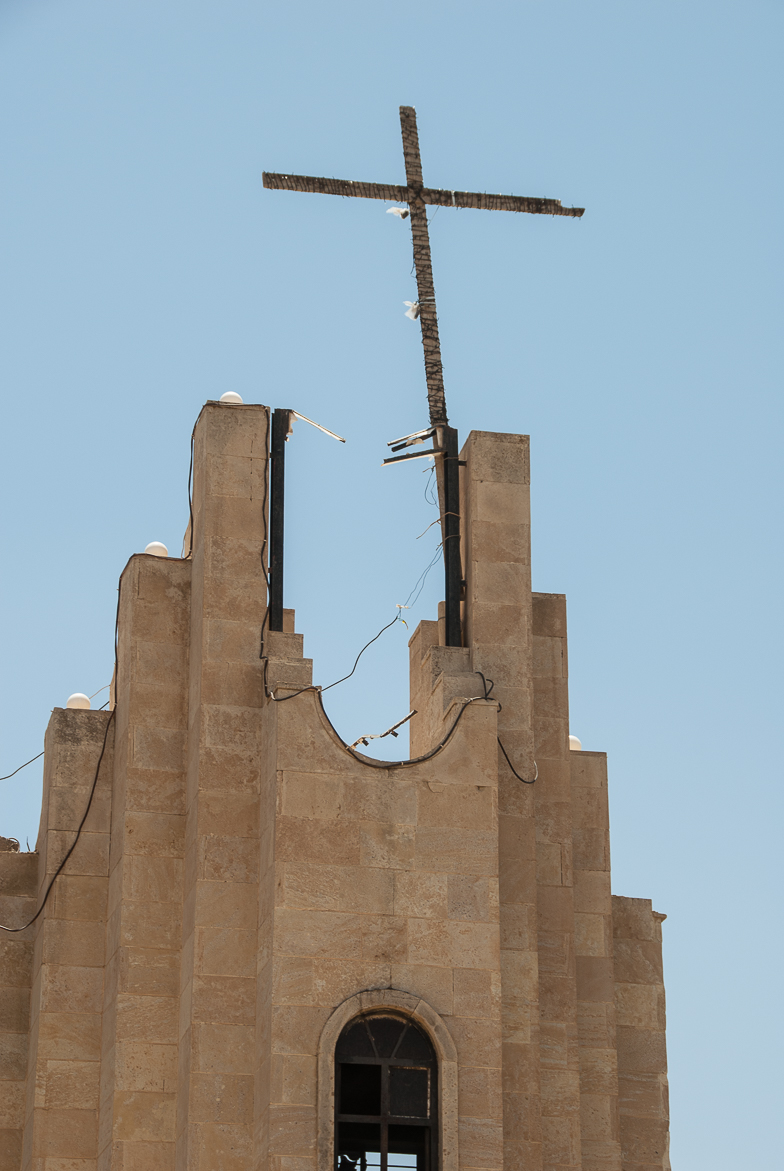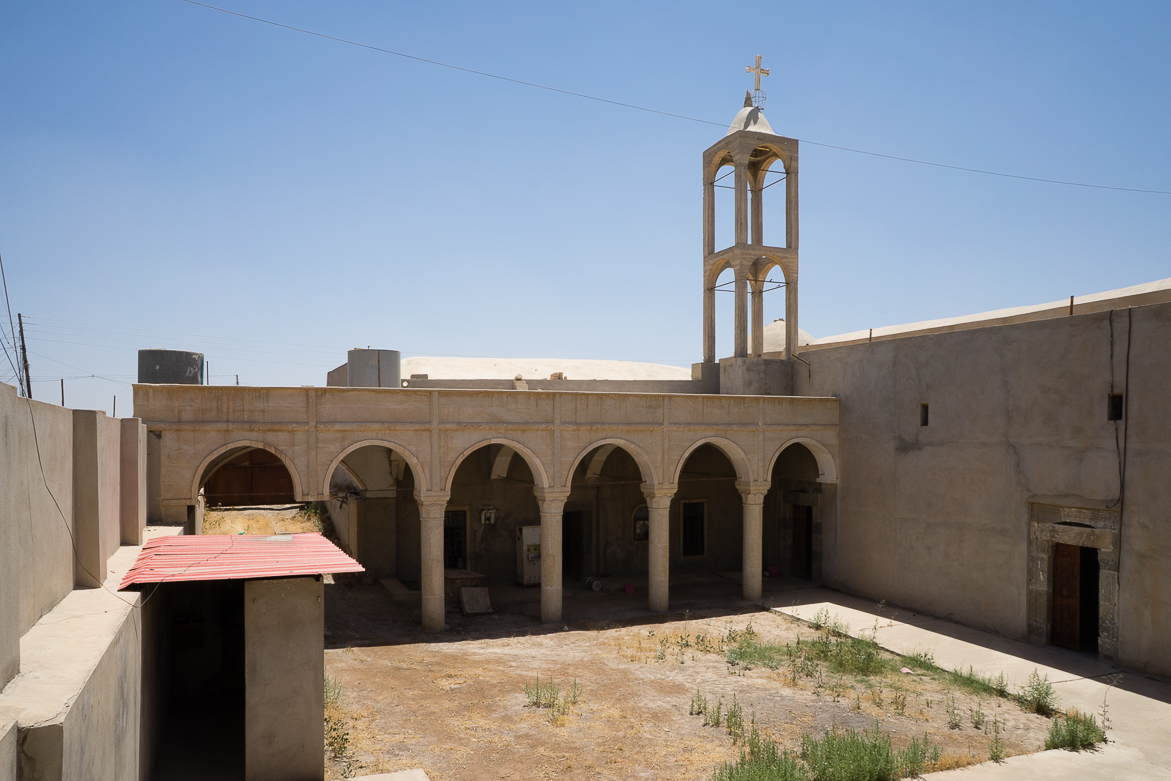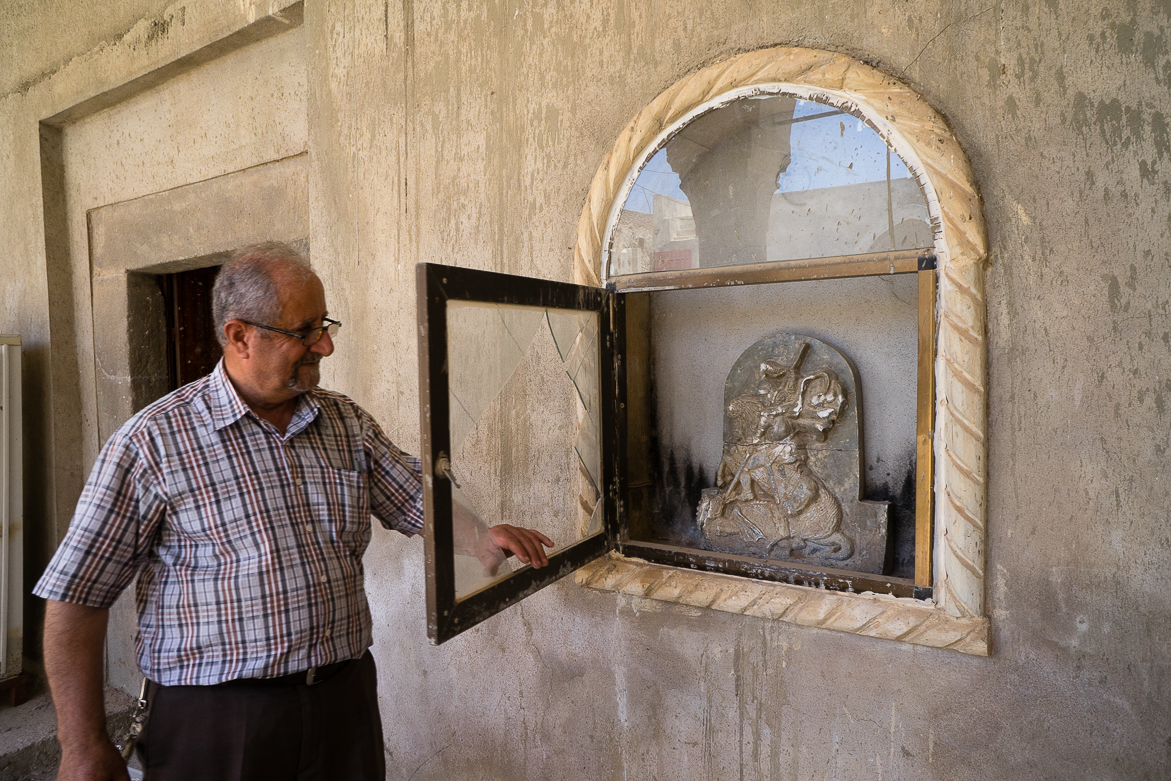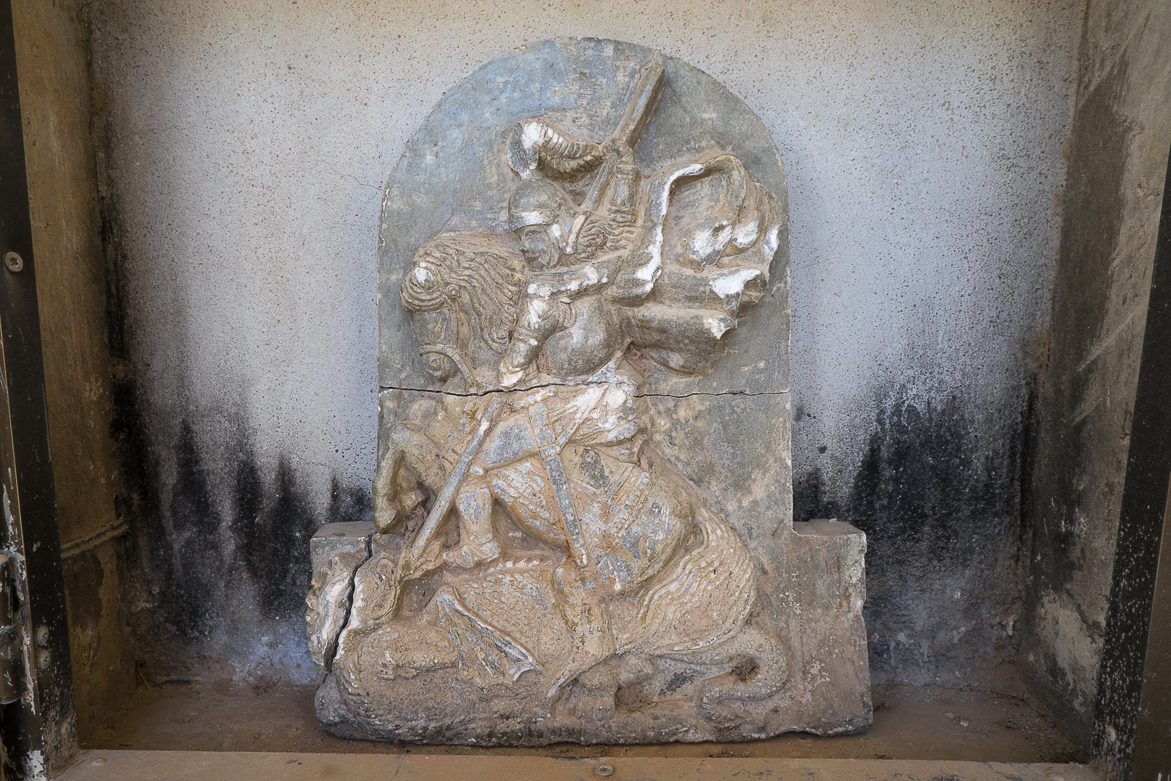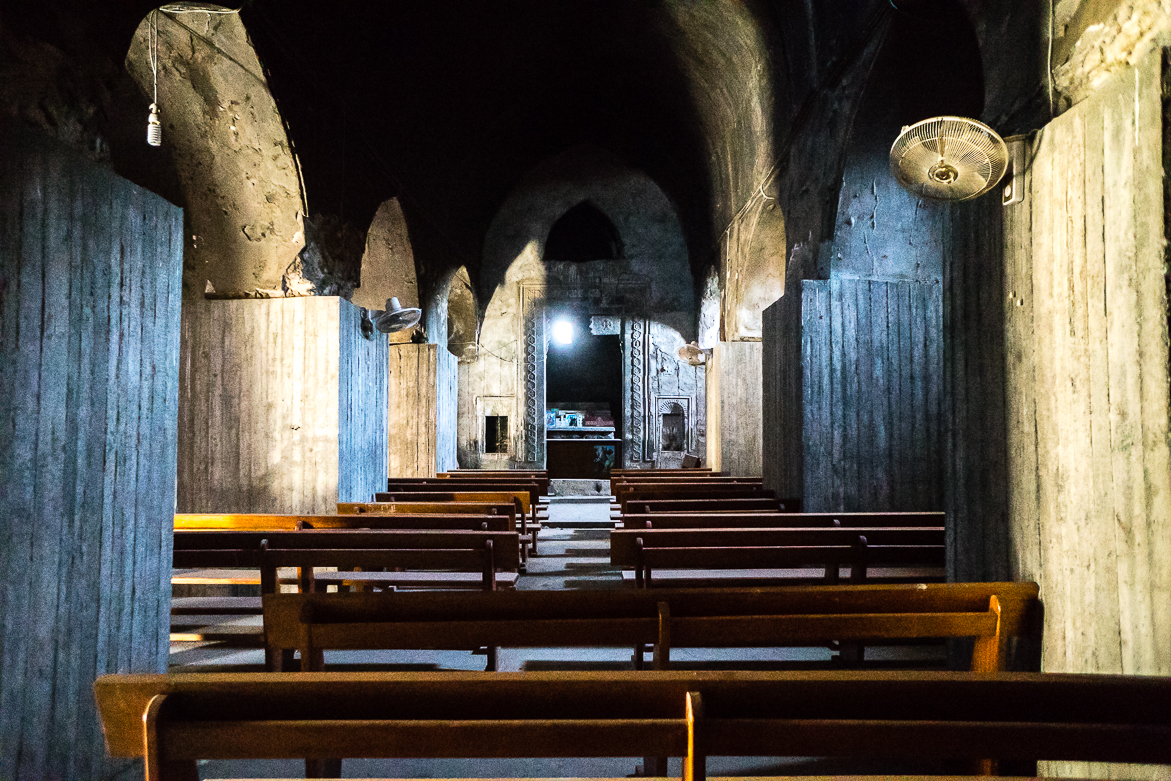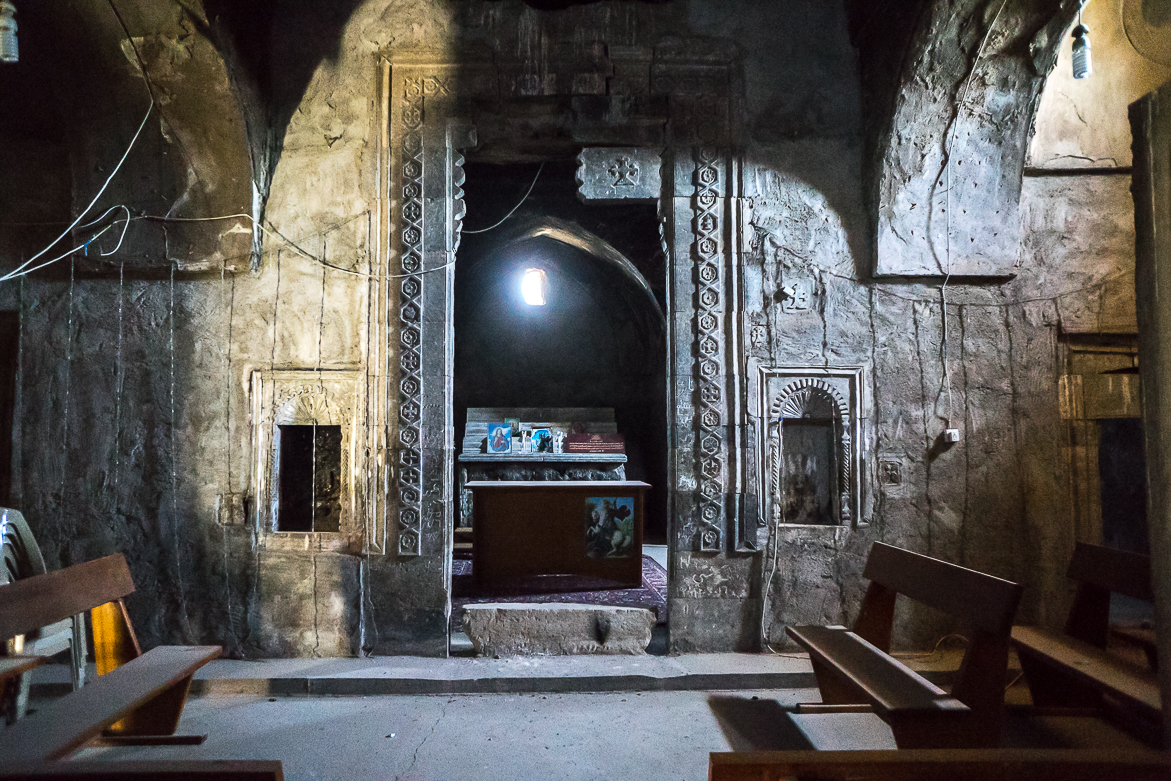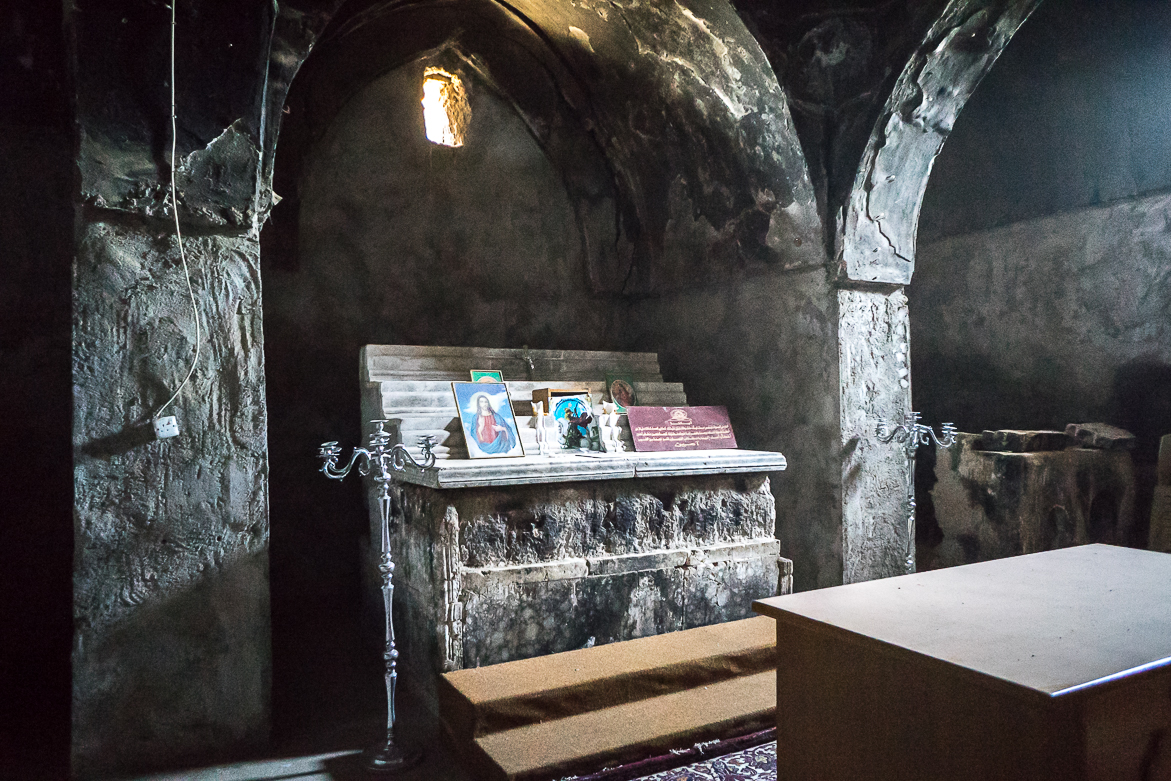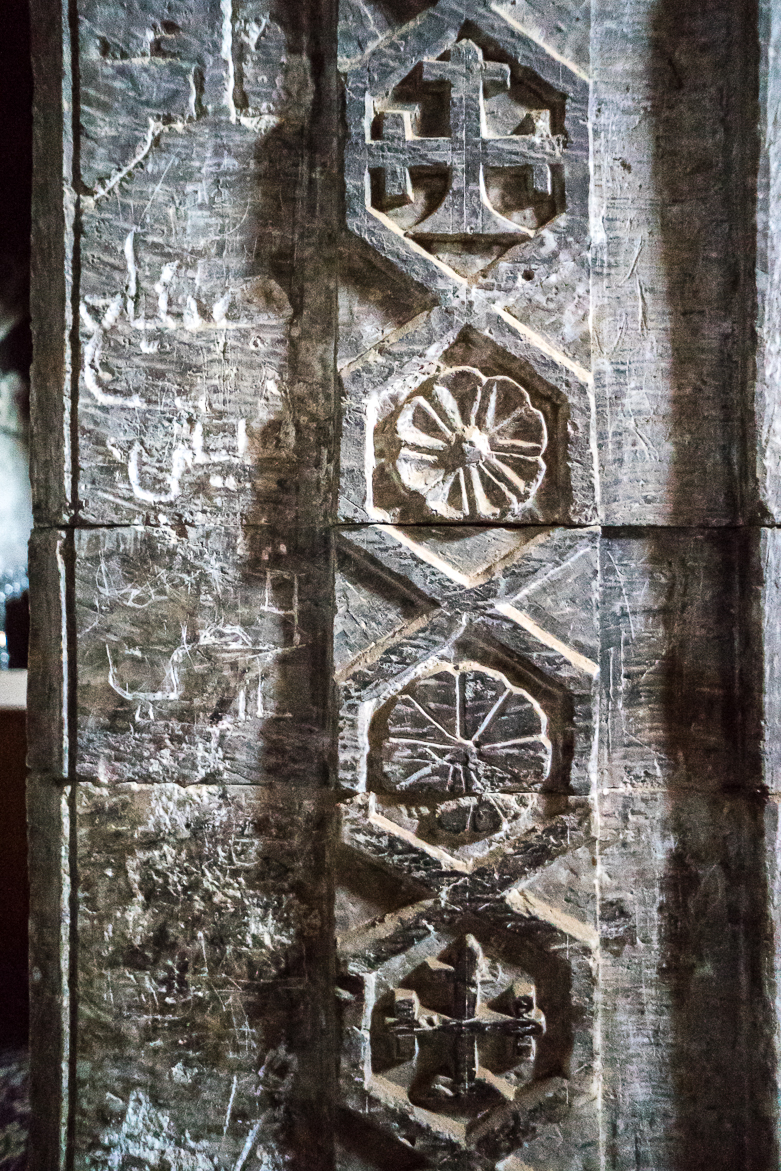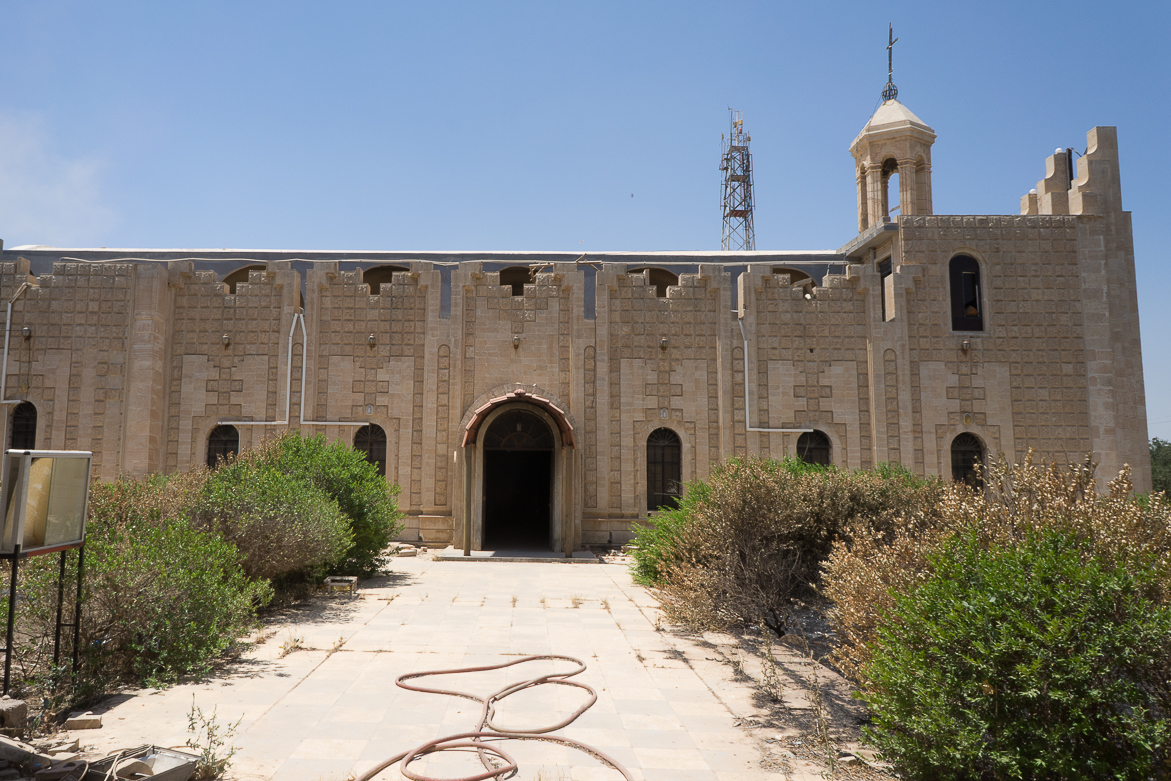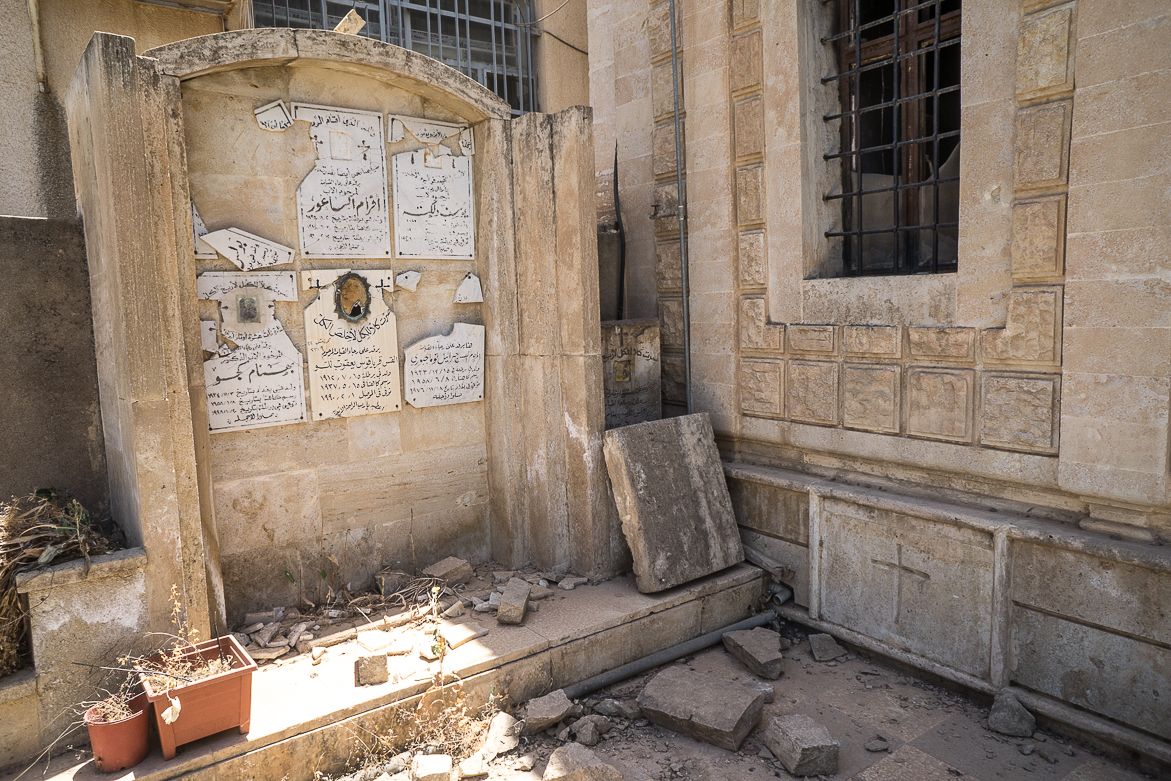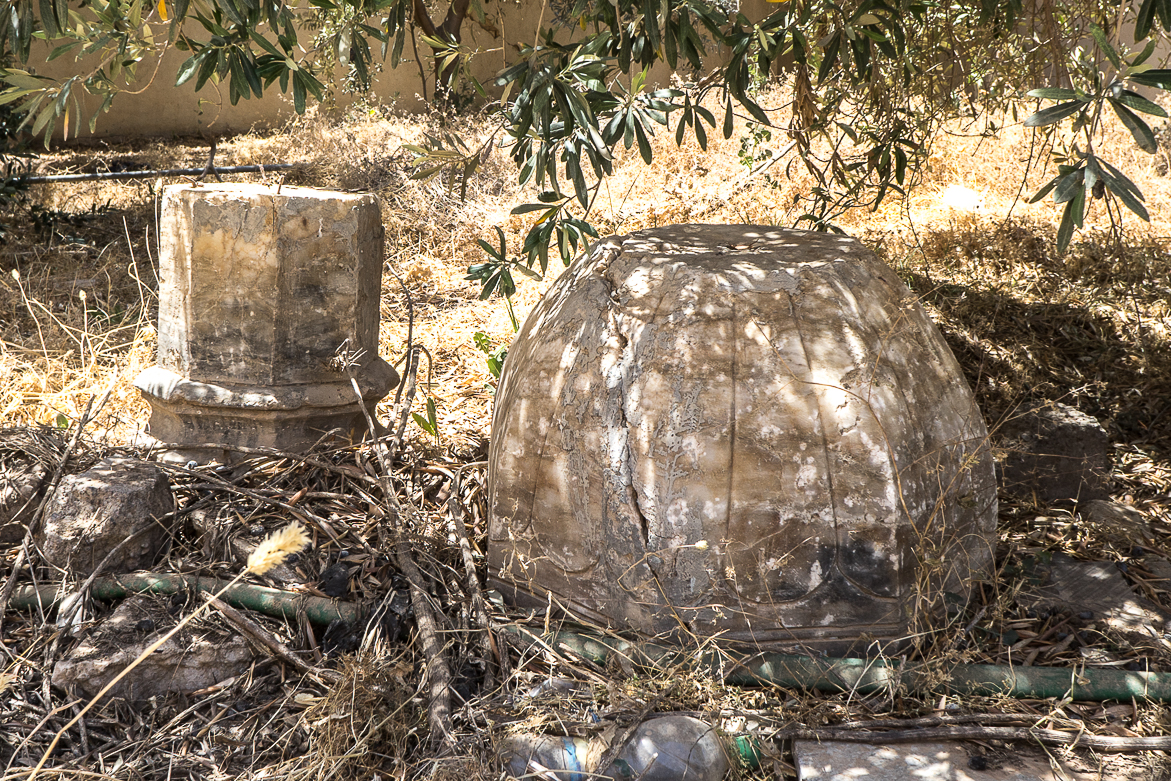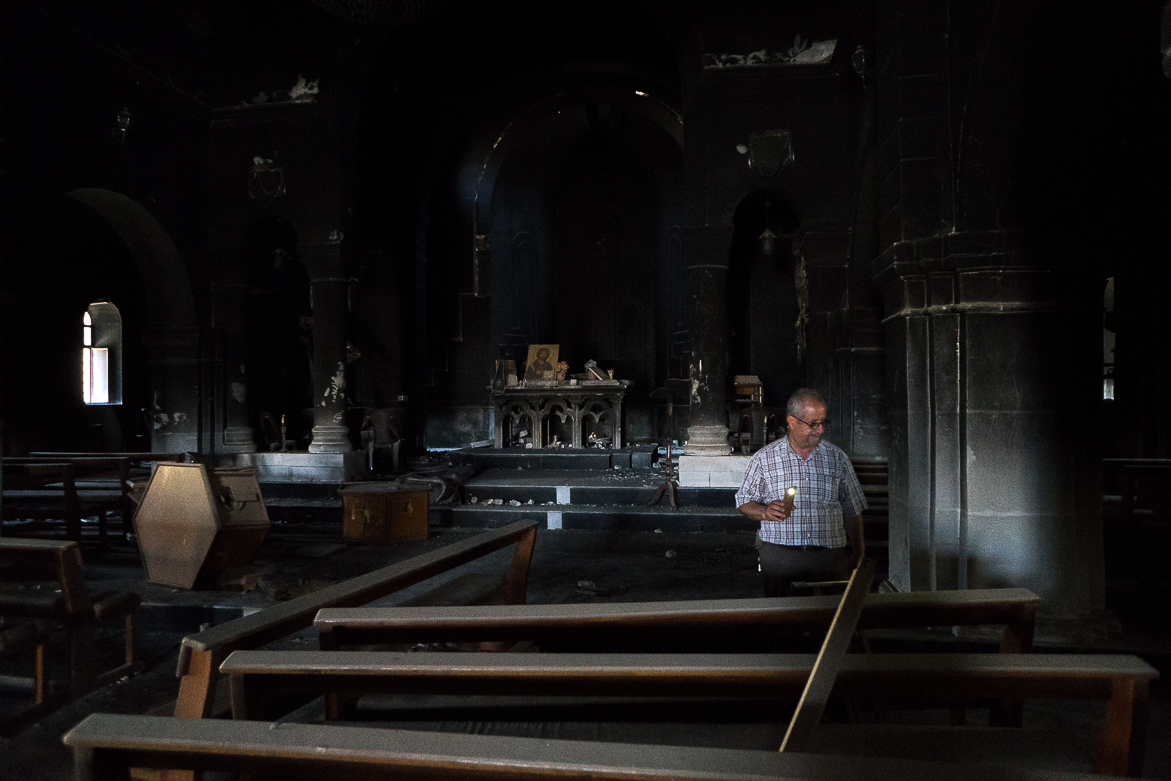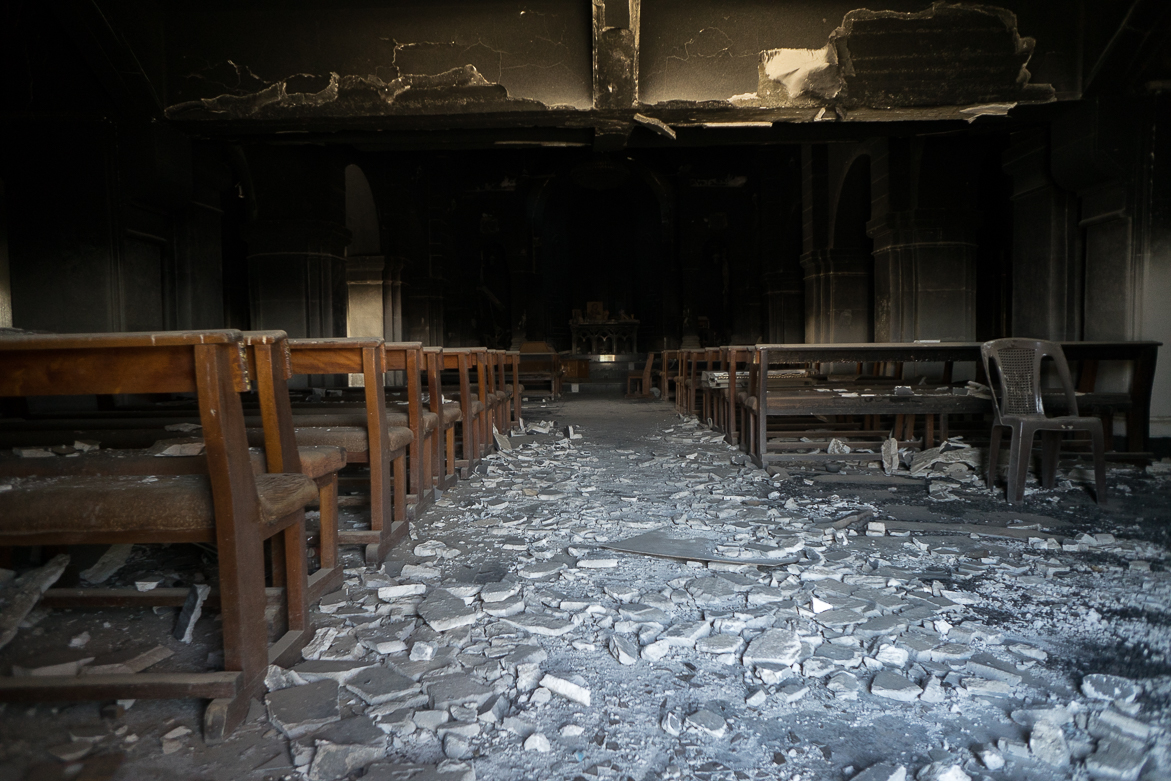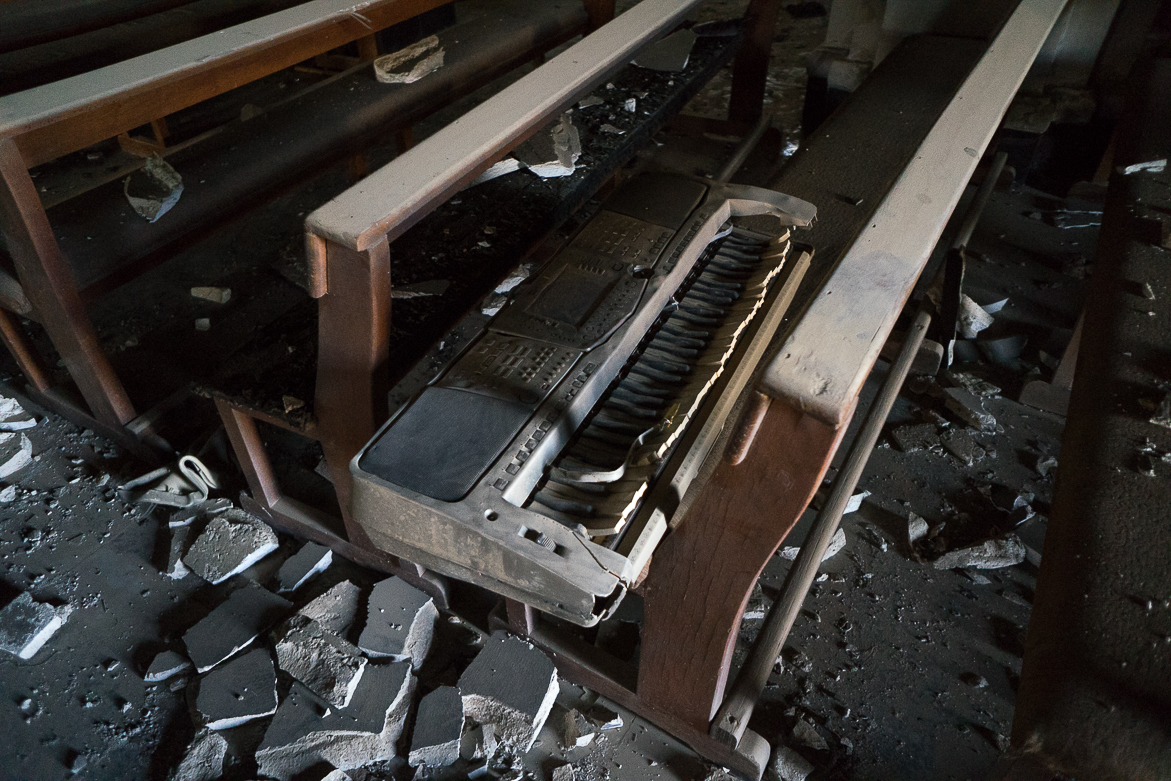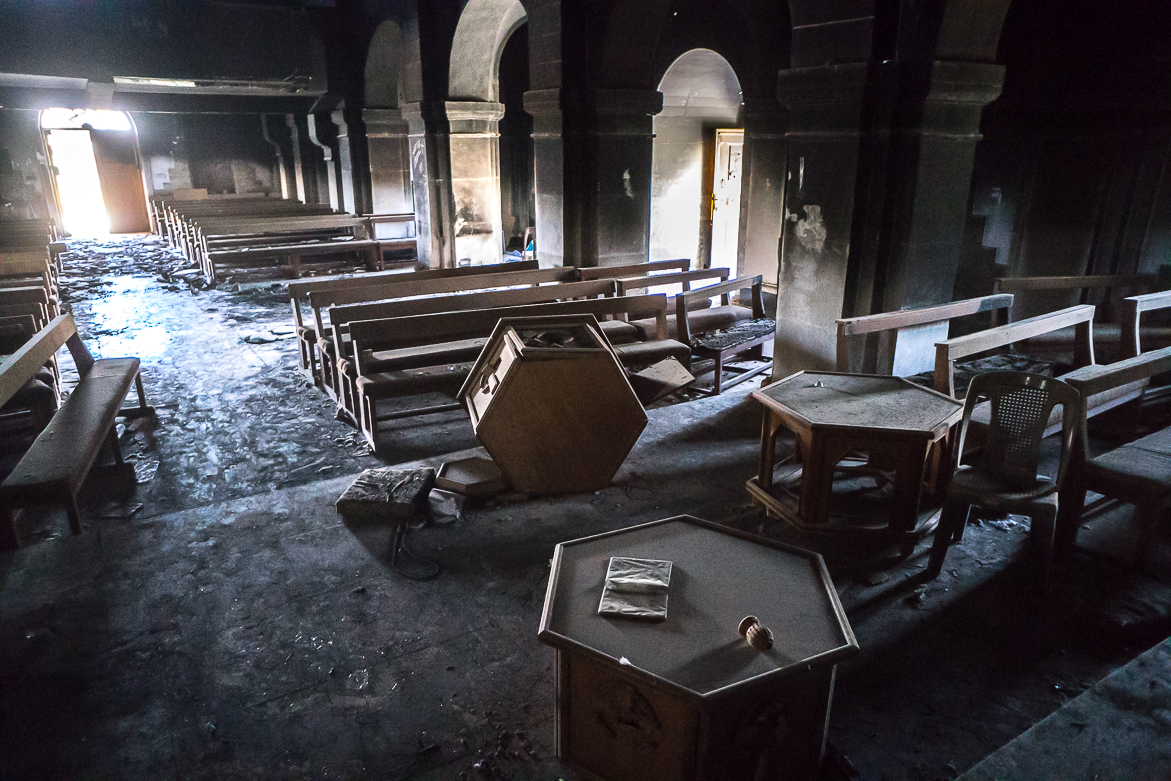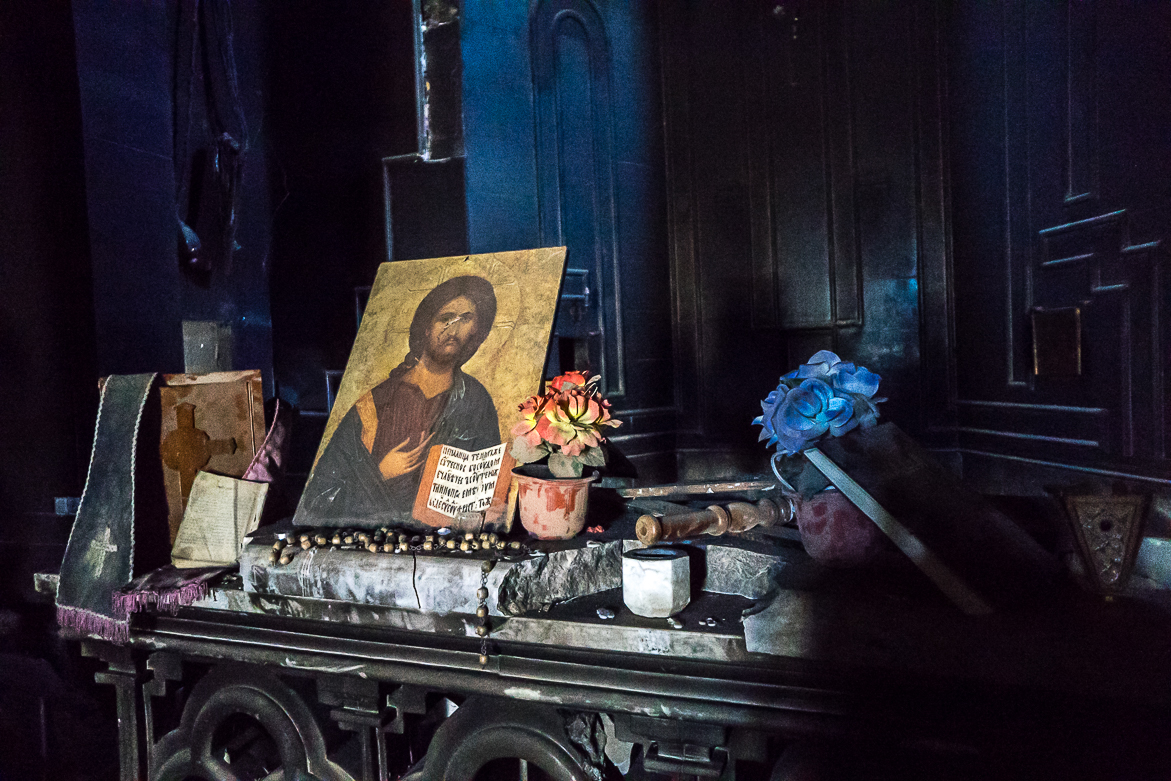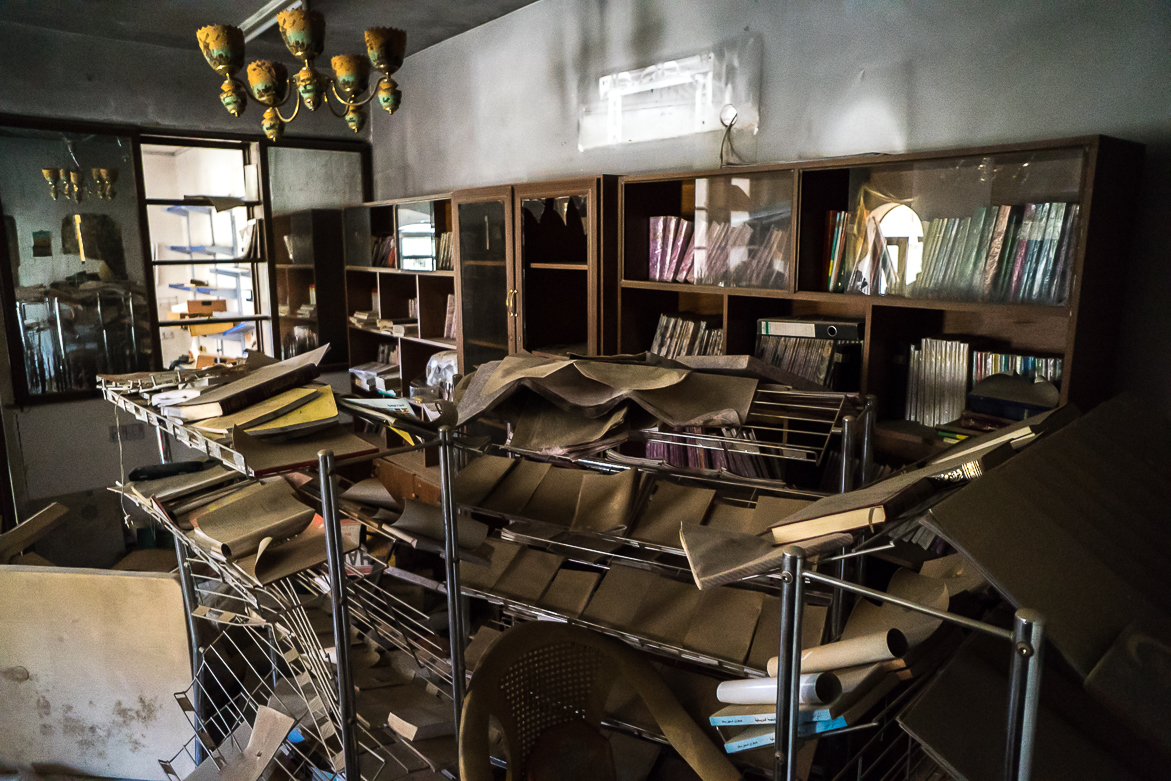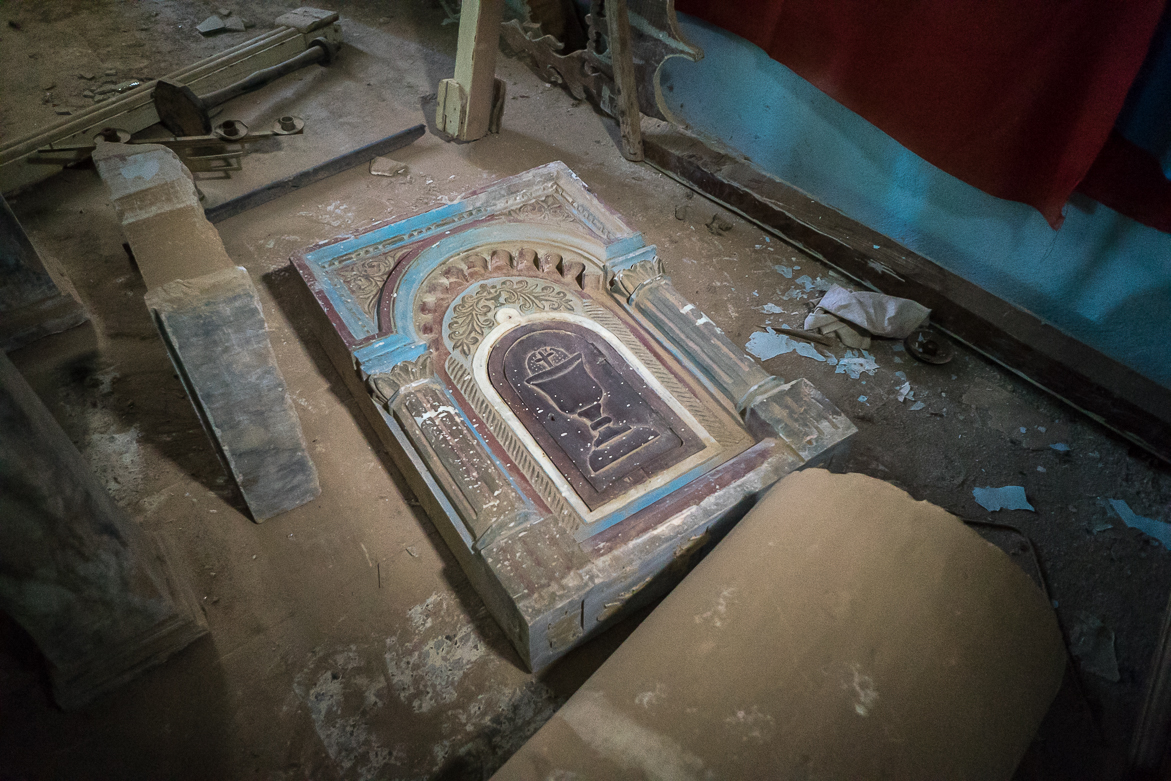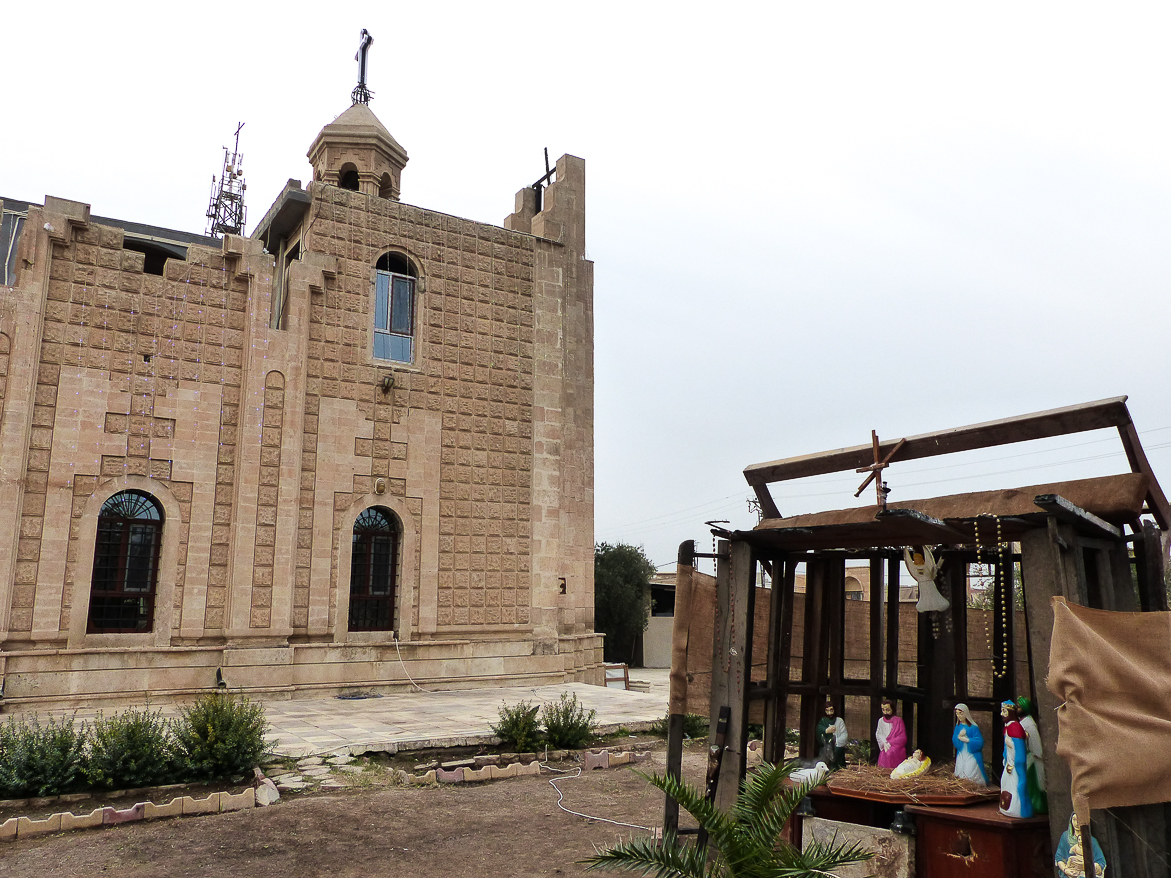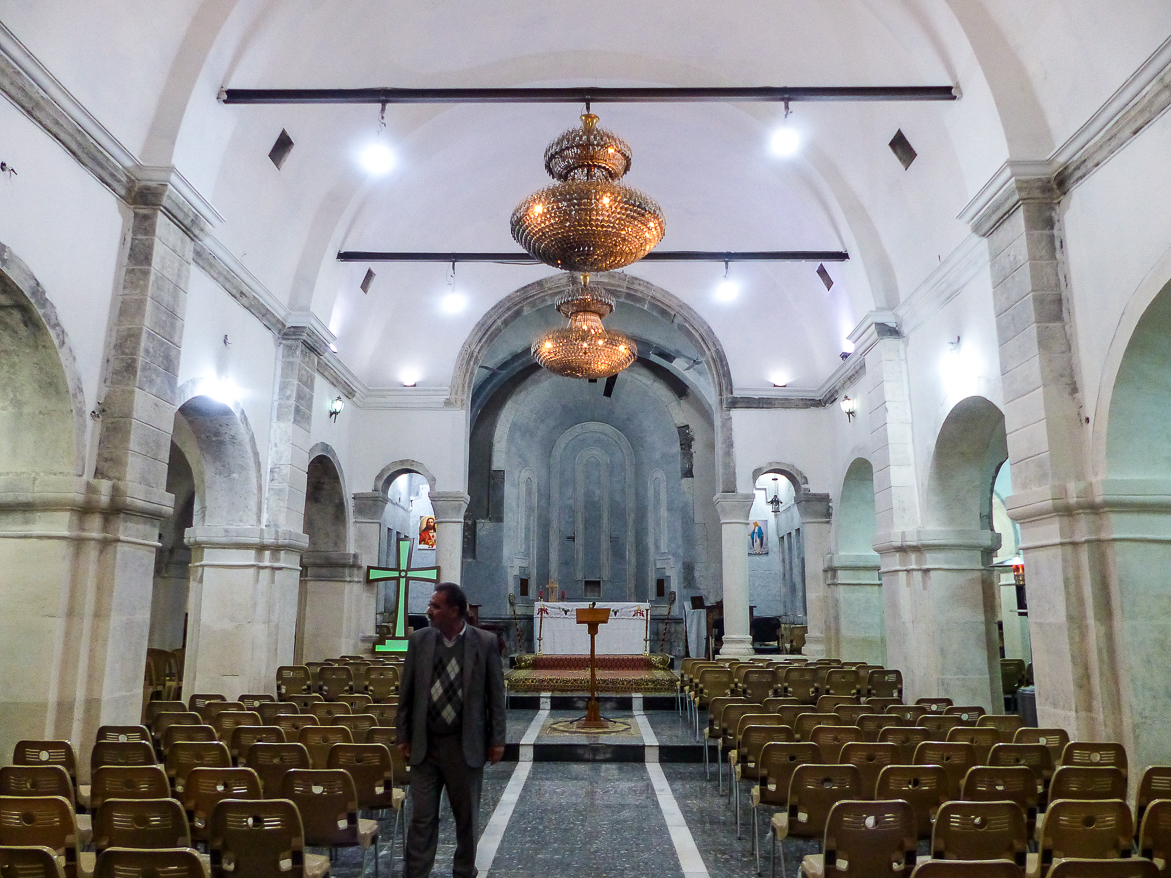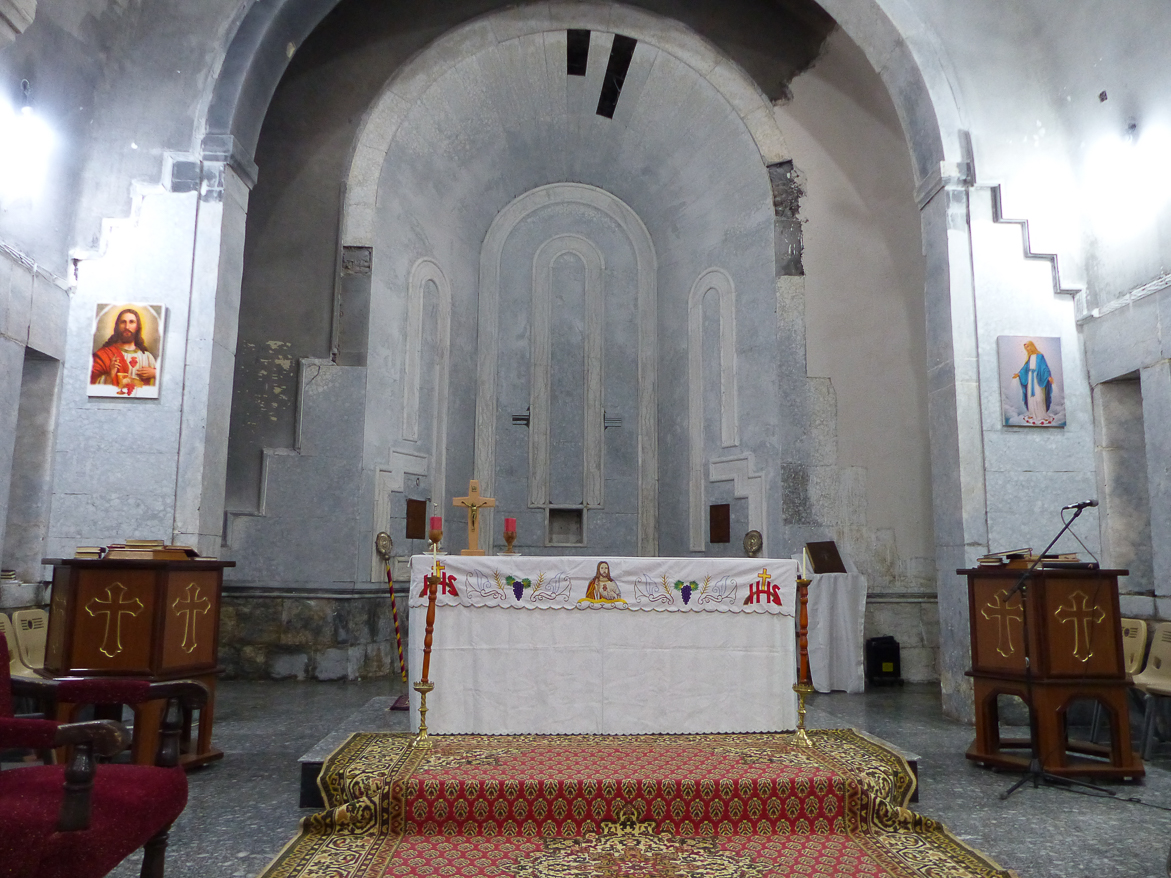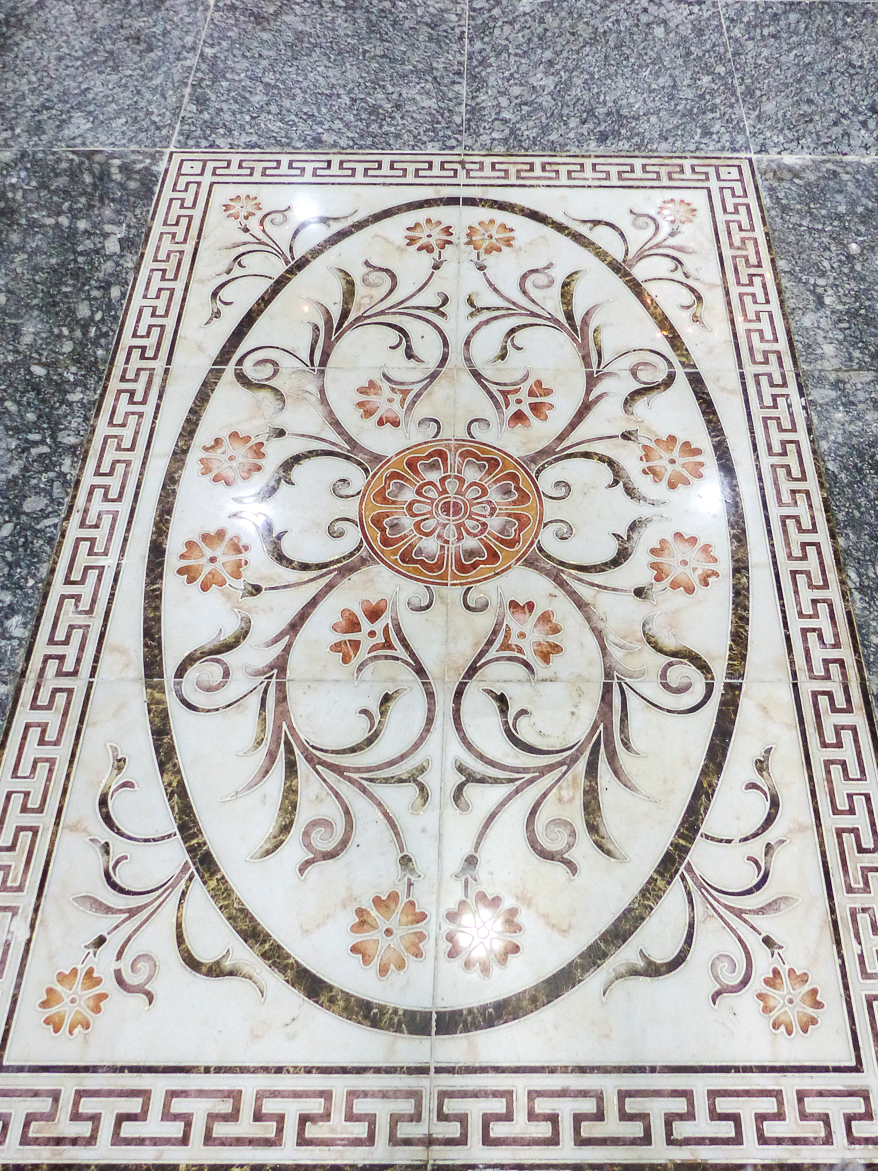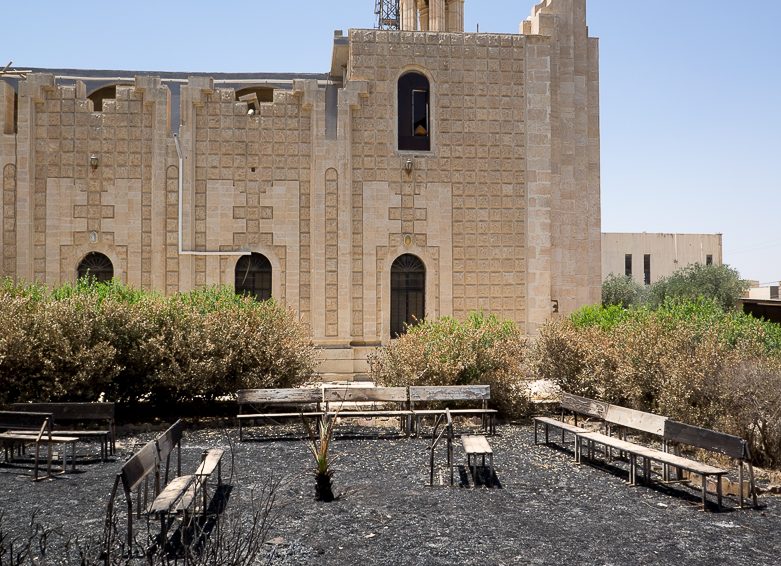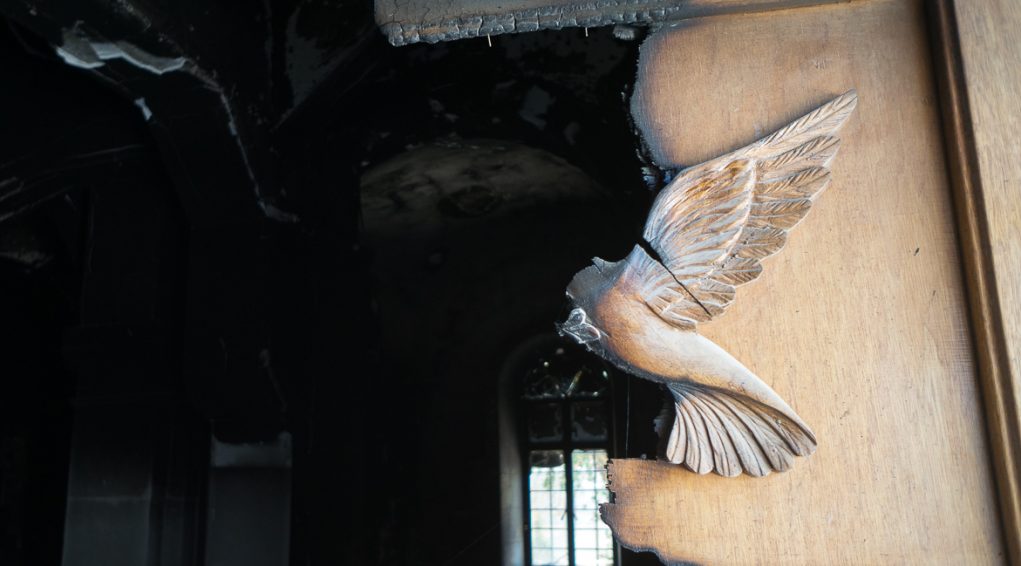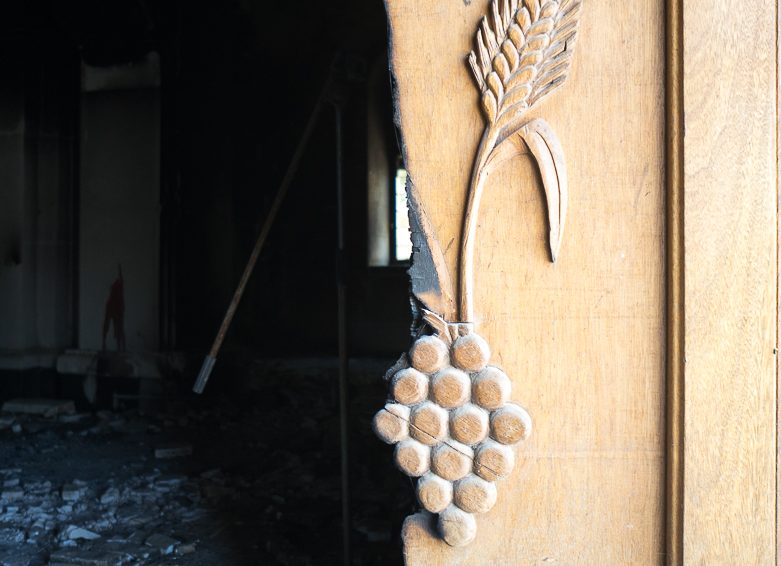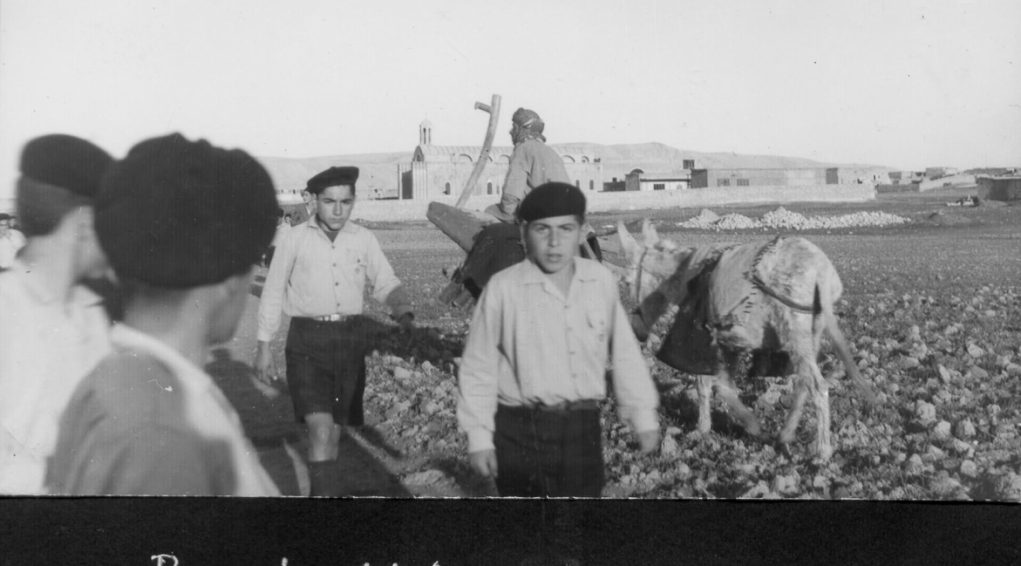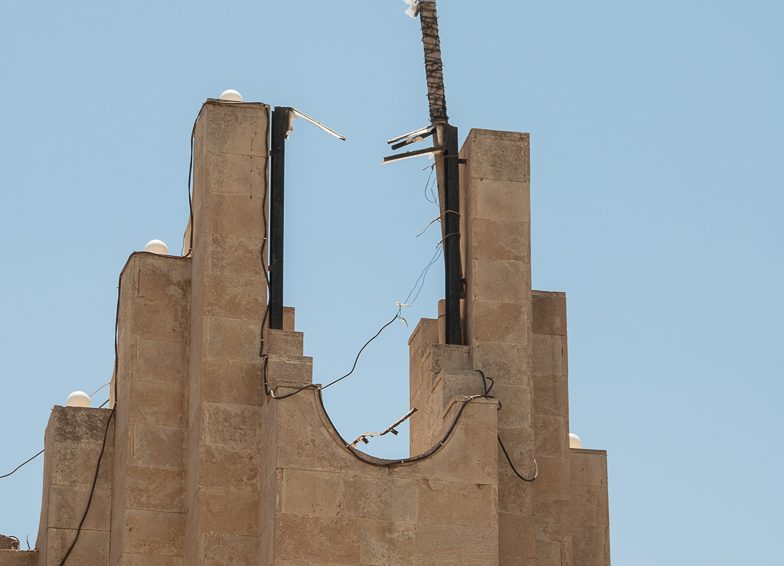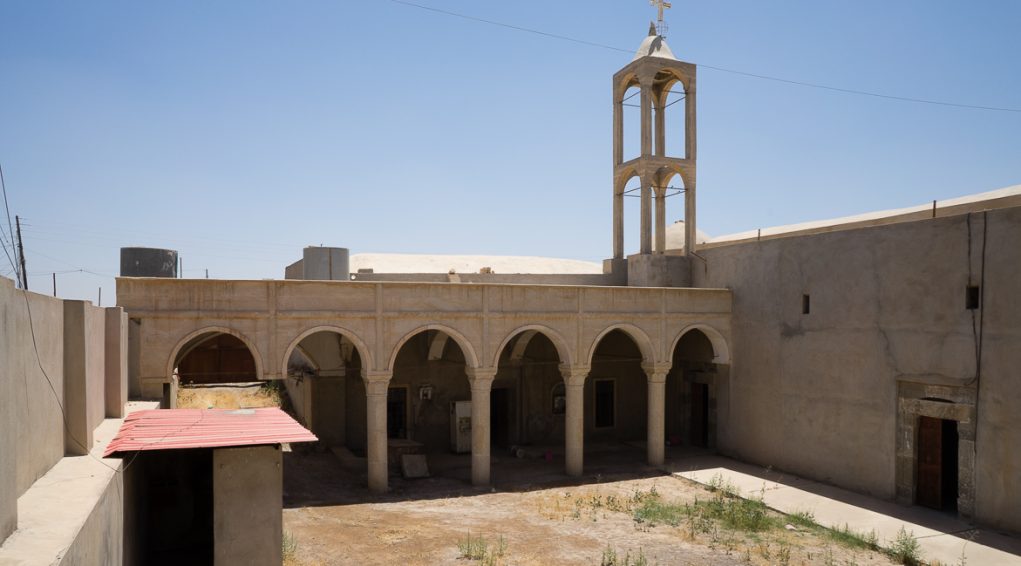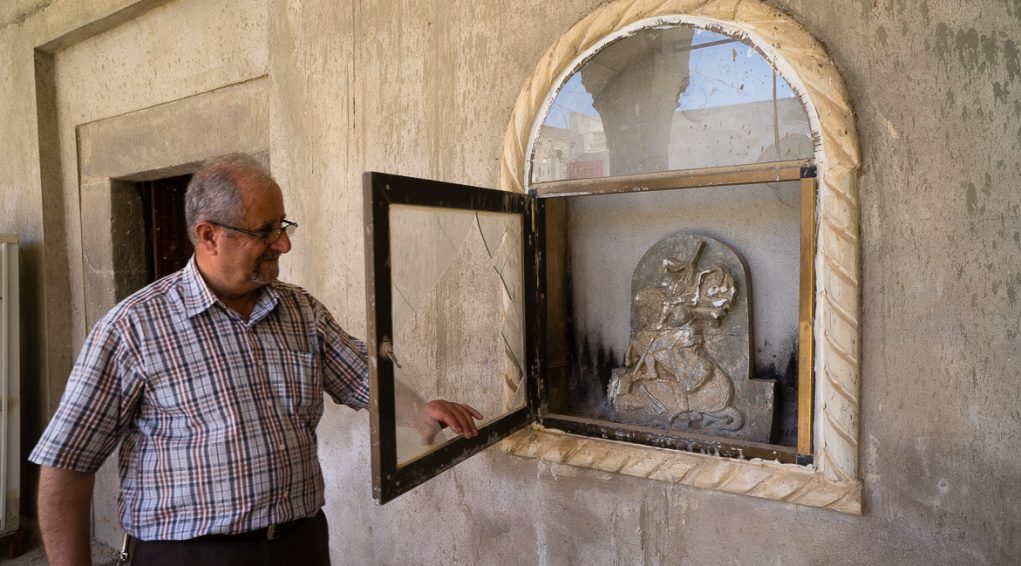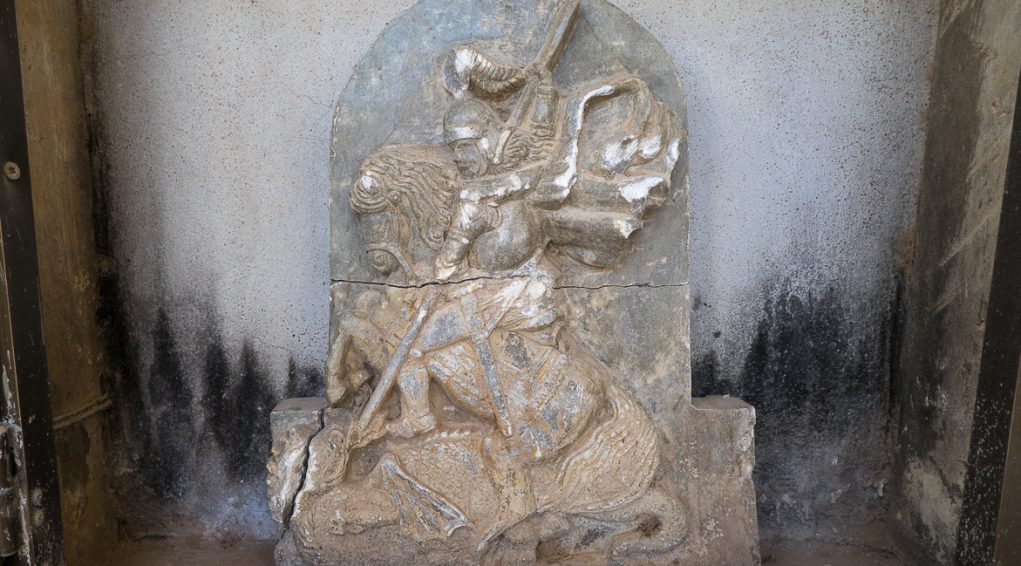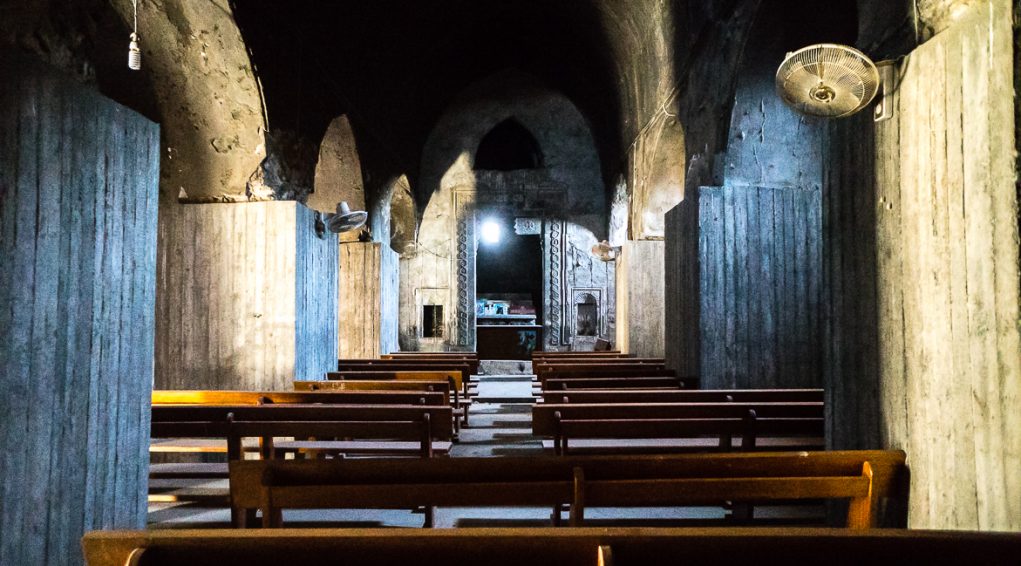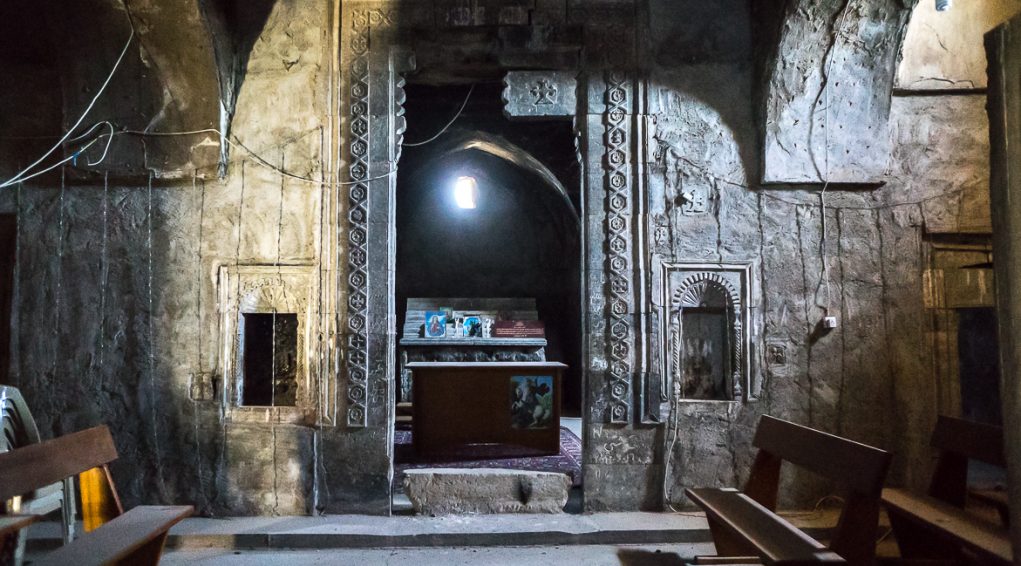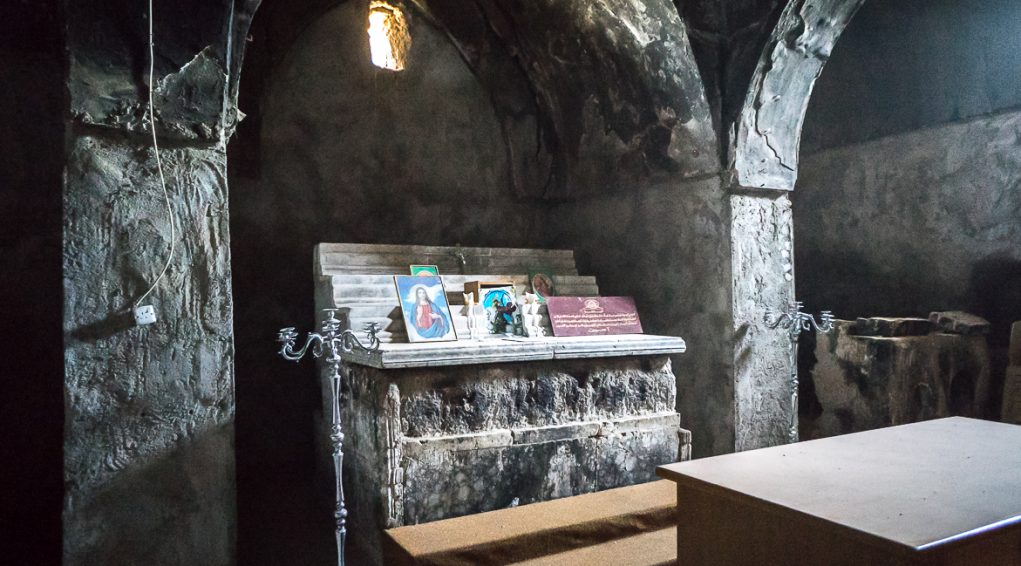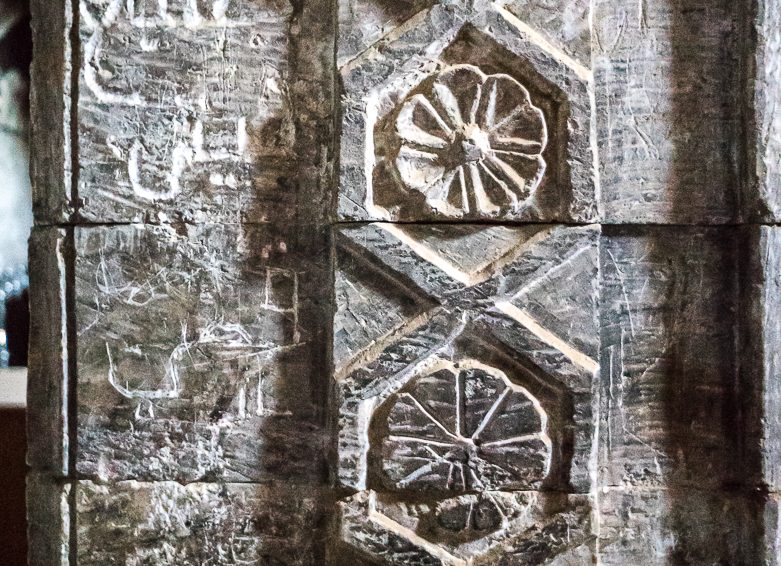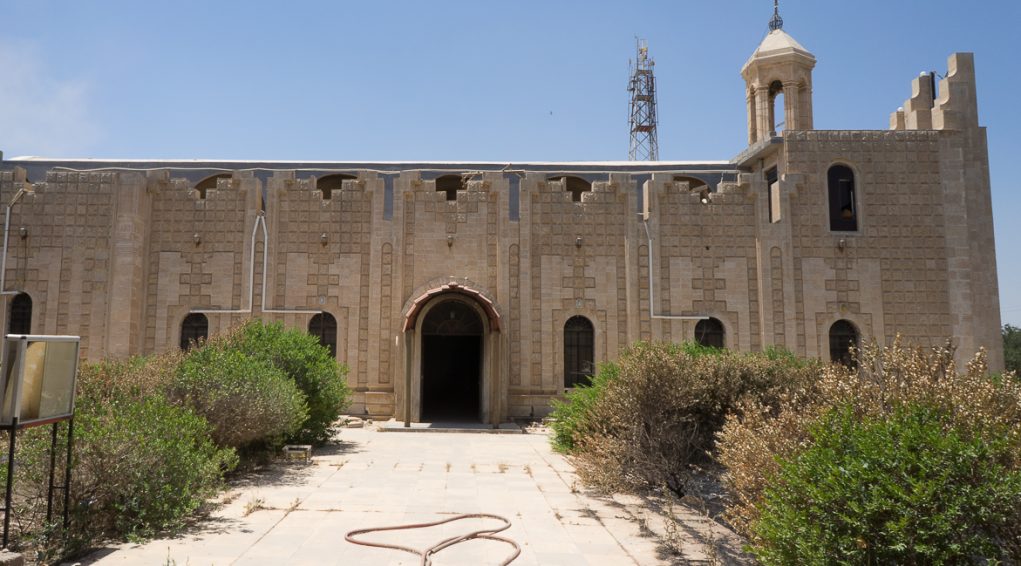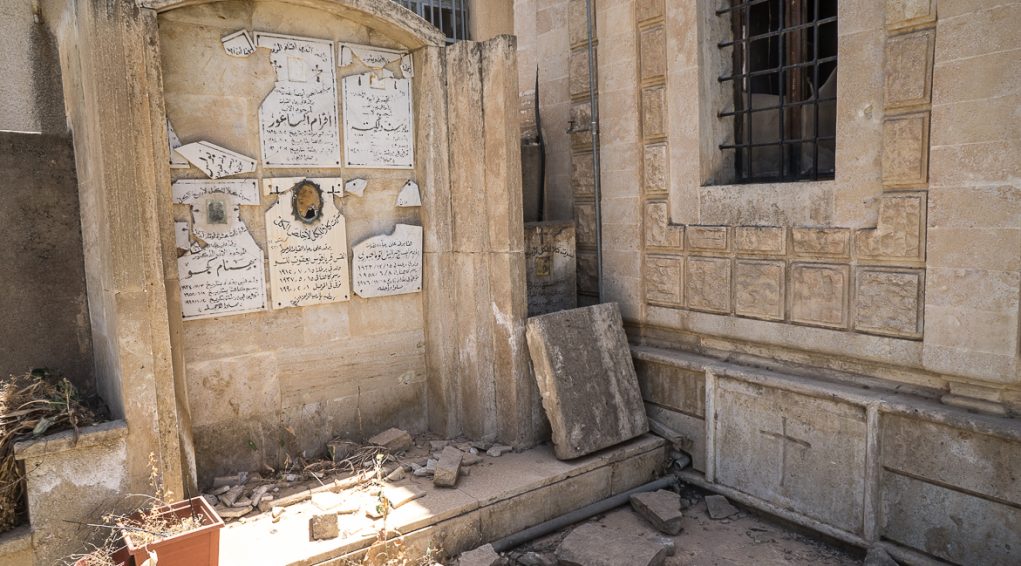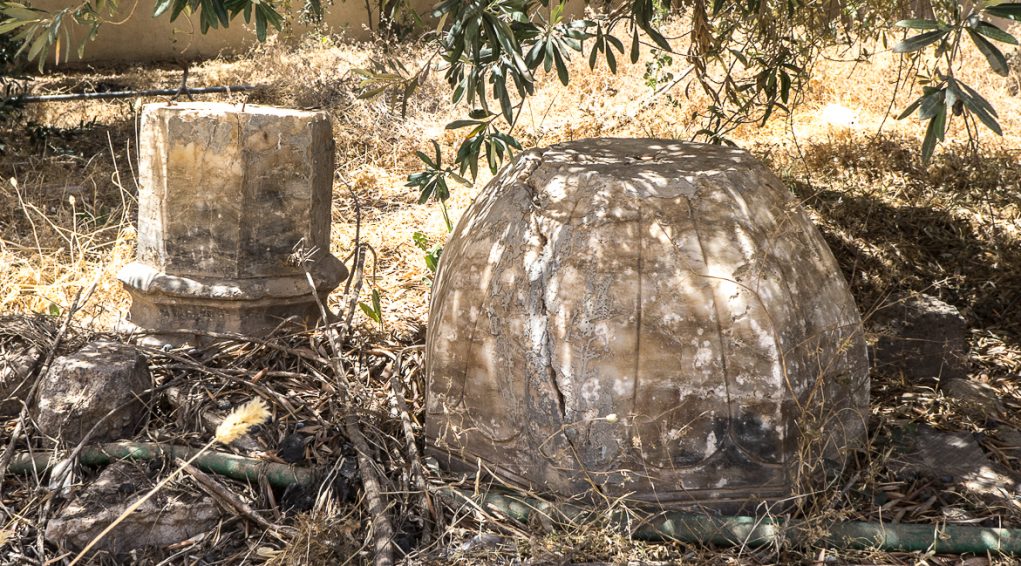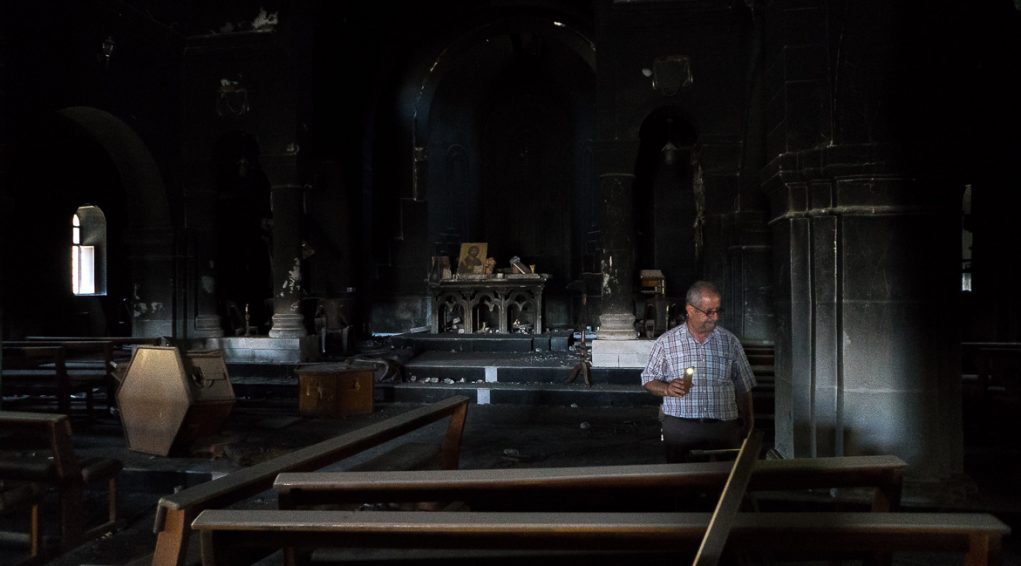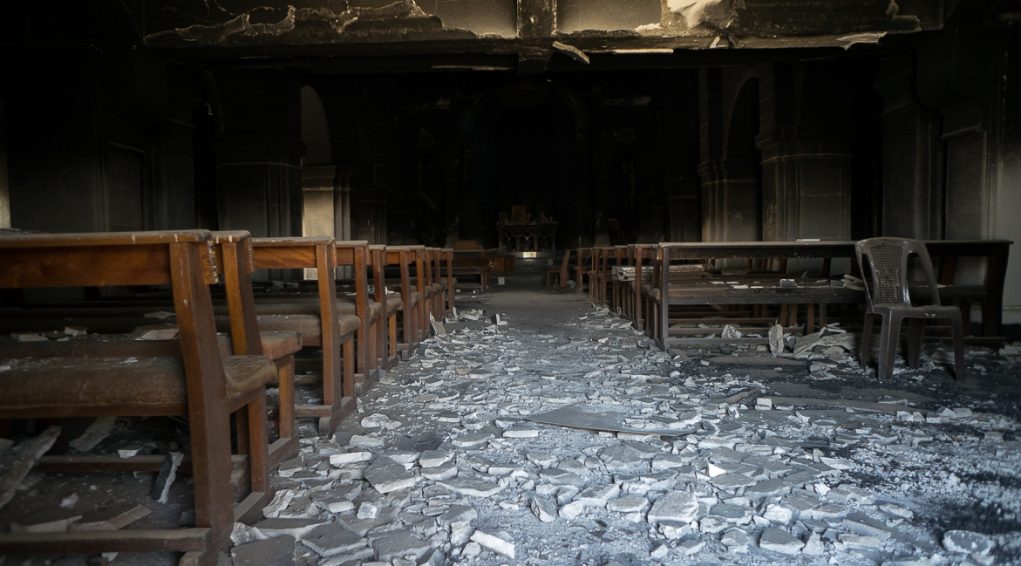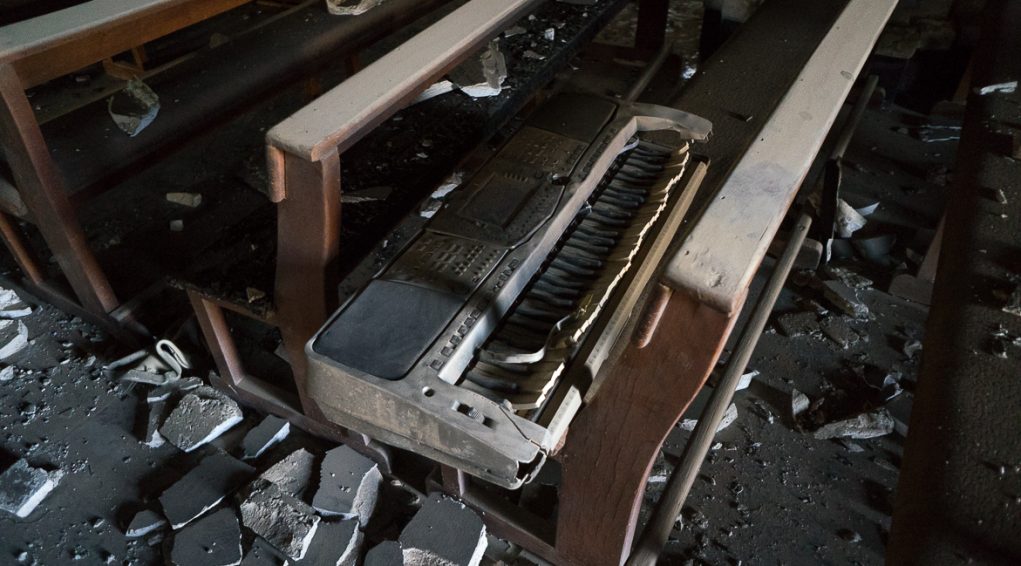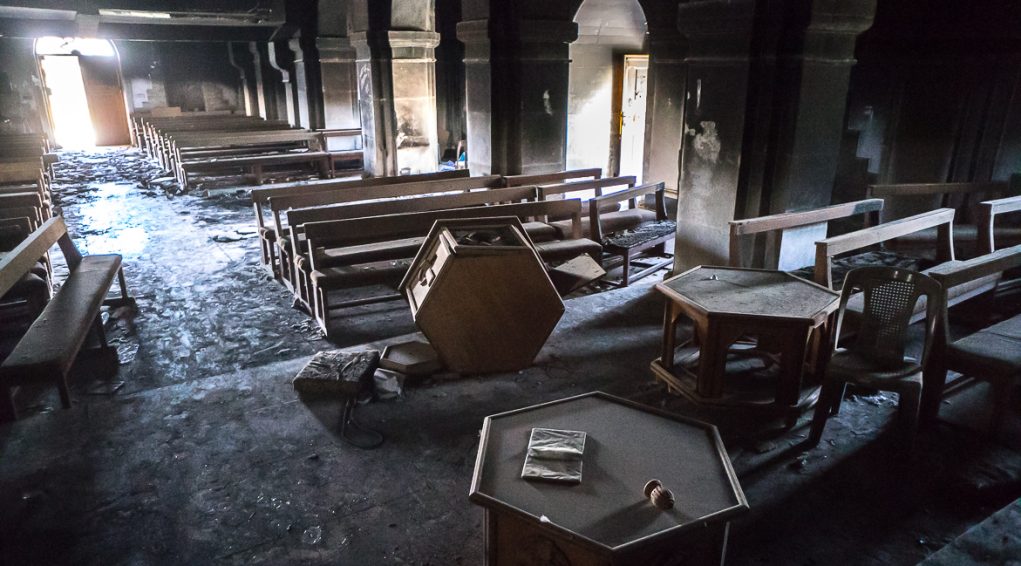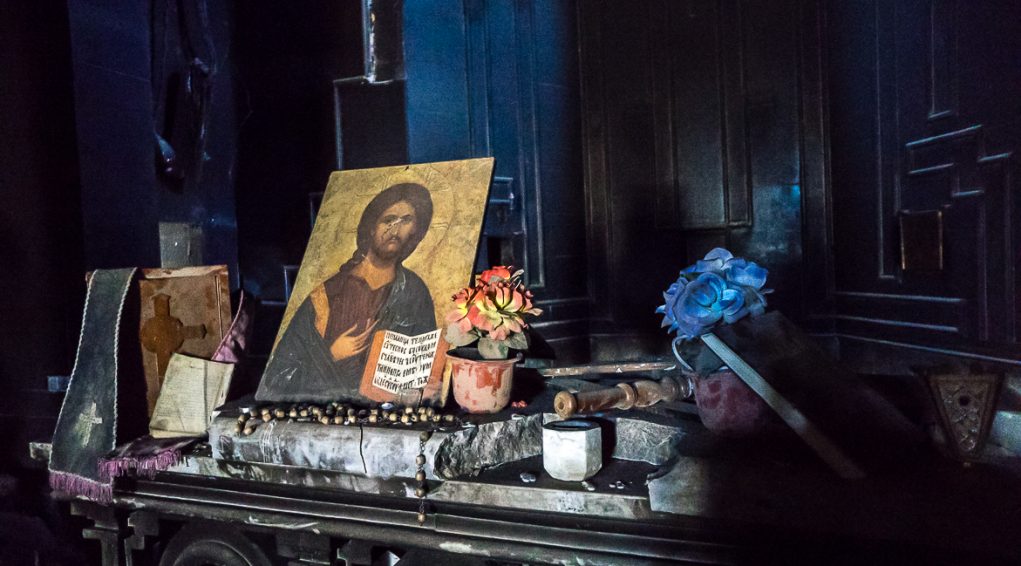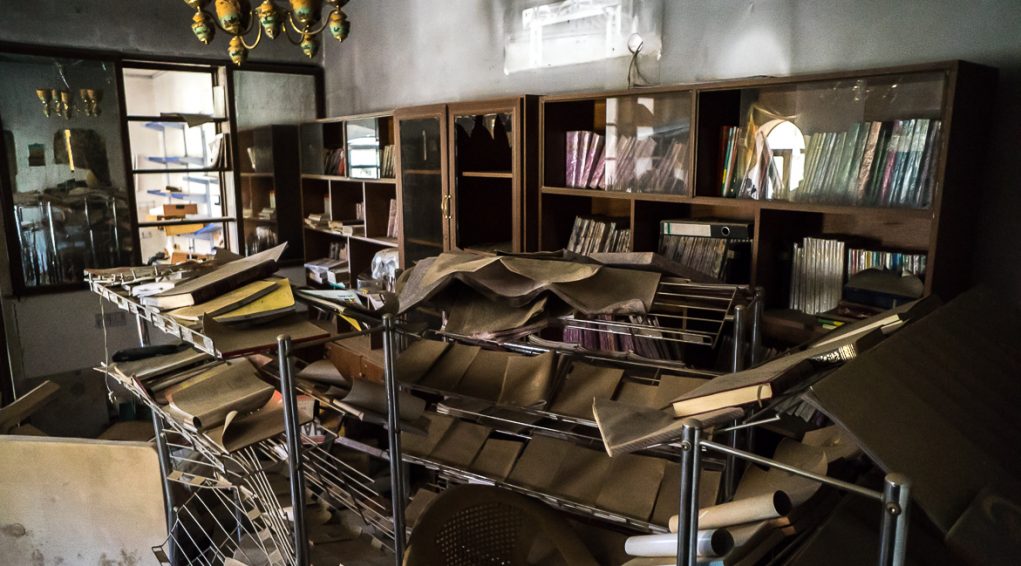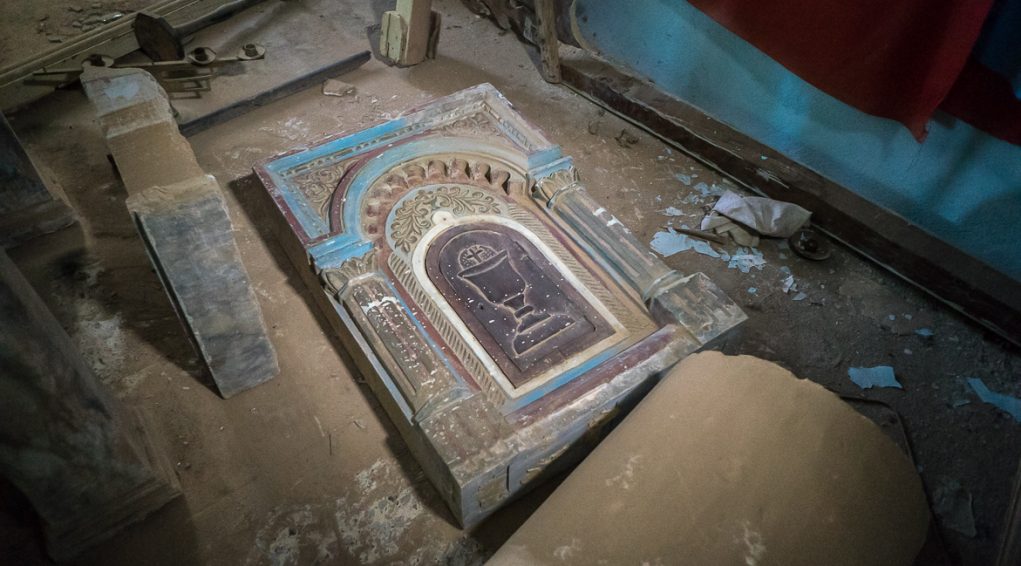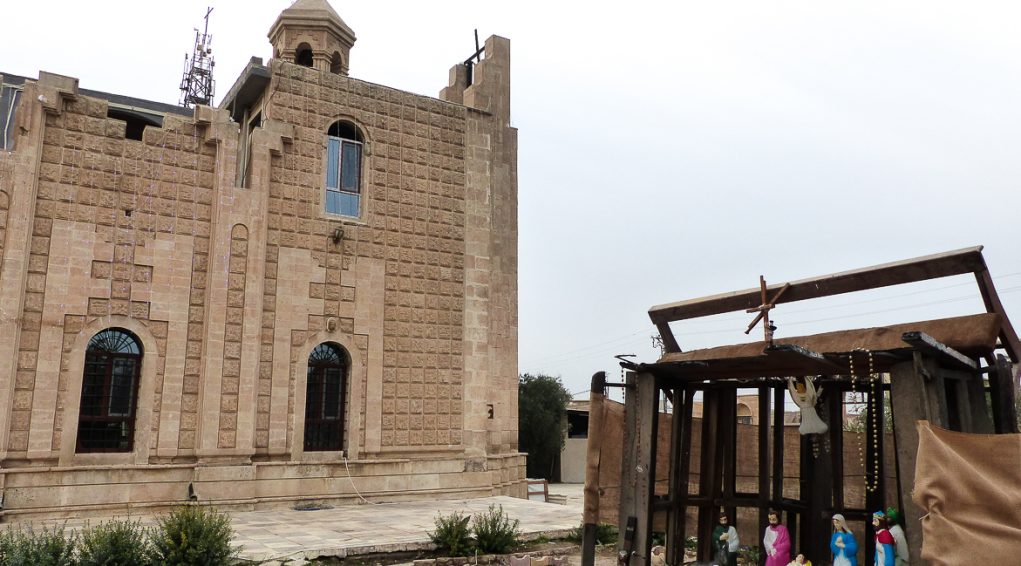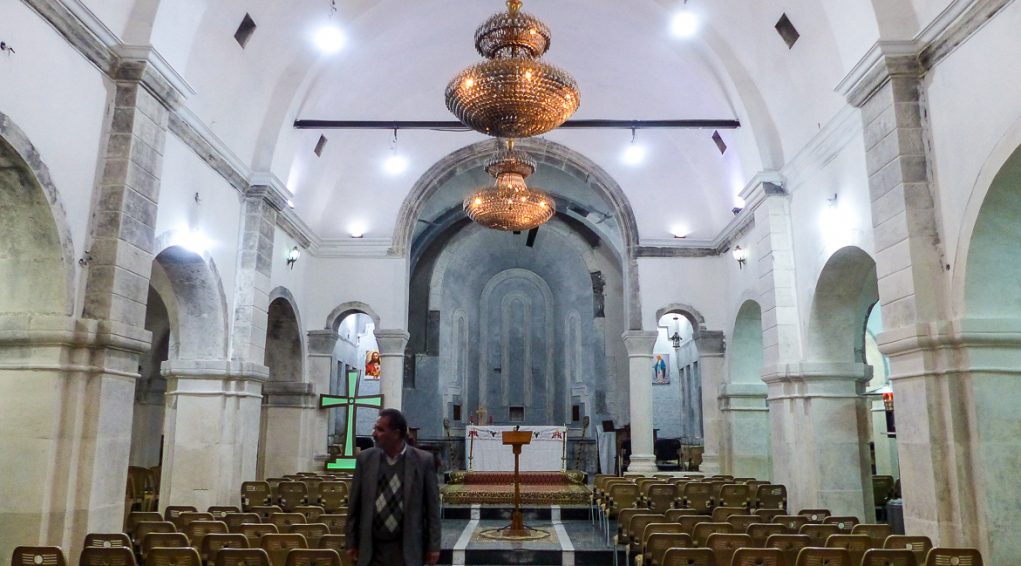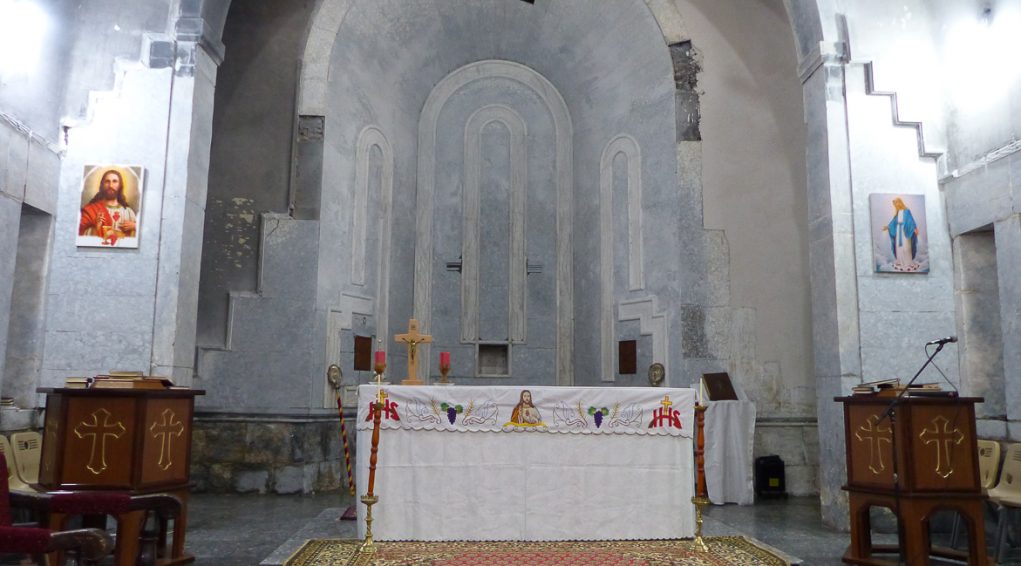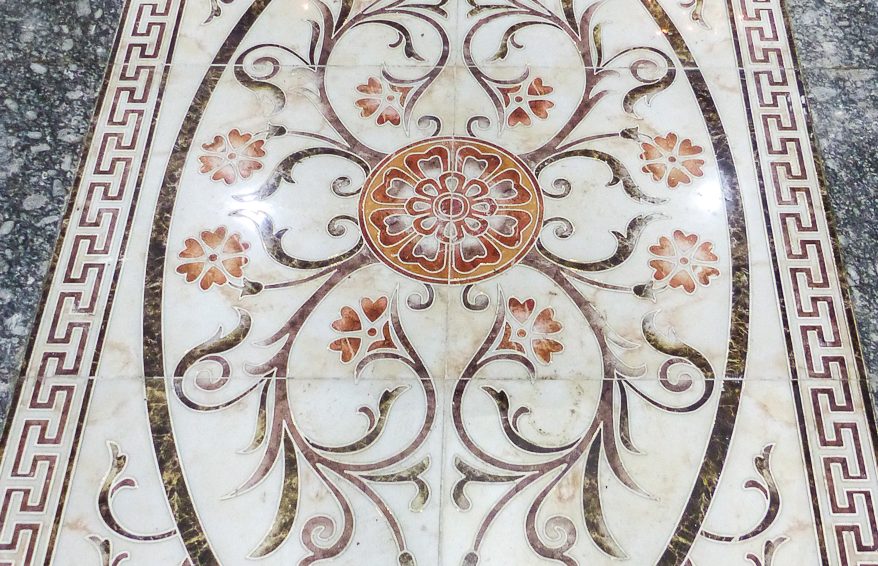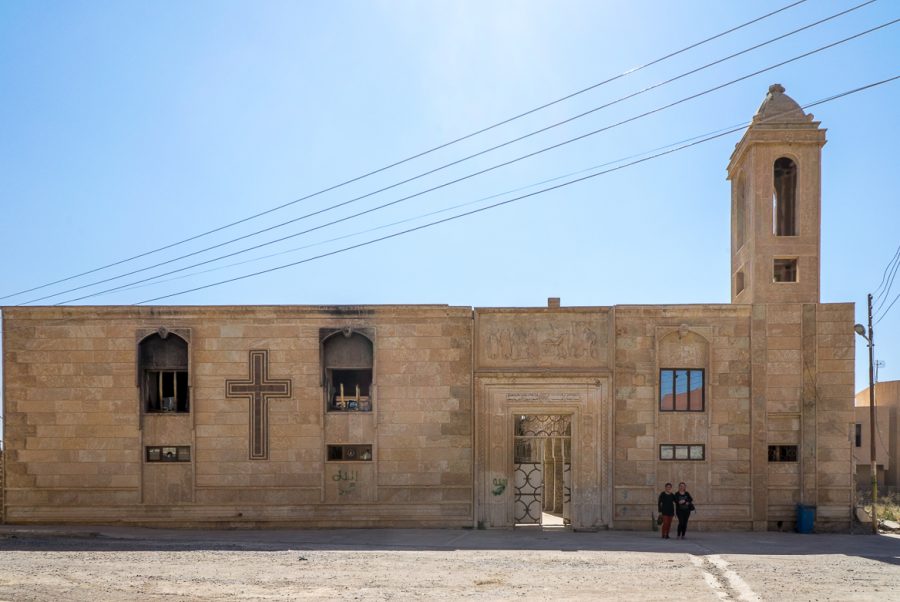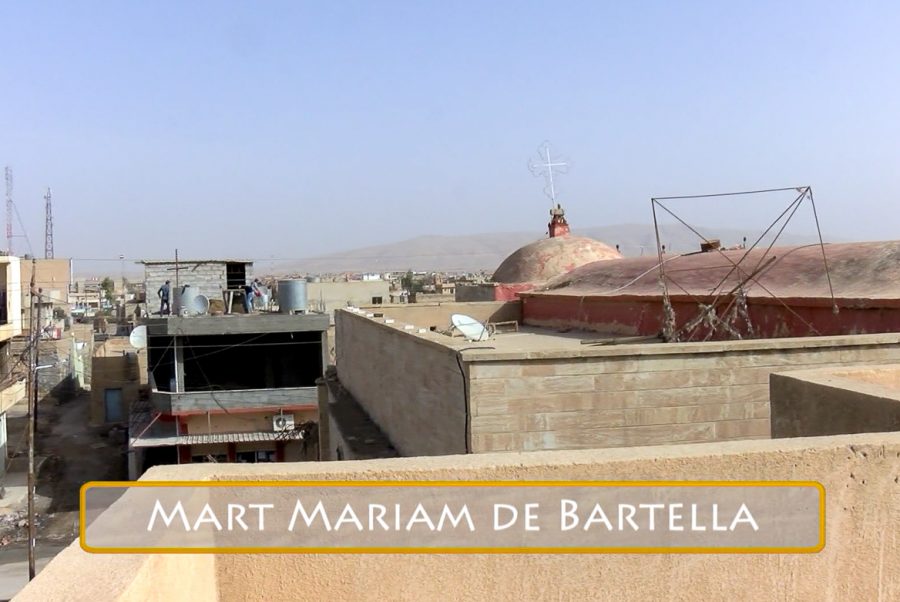The Mar Gorgis church in Bartella
The Mar Gorgis Syriac-Catholic church in Bartella is located at 36°21’06.78”N 43°22’36.48”E and 288 metres’ altitude.
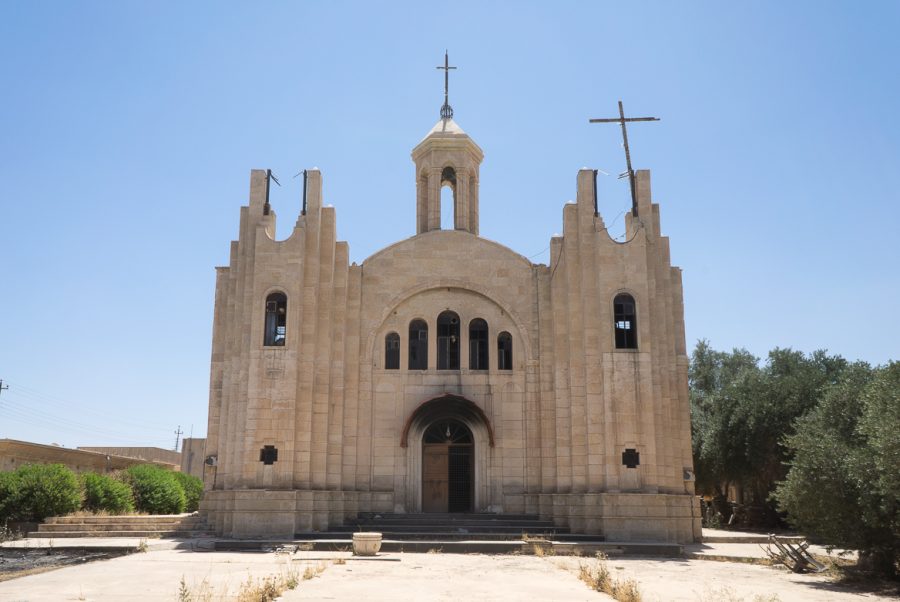
The date of construction of the ancient Mar Gorgis church is unknown but we do know that it was renovated in the middle of the 19th century. The new Mar Gorgis church was built in 1934. The new Mar Gorgis was destroyed and burned down by ISIS during its occupation of the city. Since the liberation of Bartella, major renovation and regeneration work has been undertaken to return Mar Gorgis to its former glory and make it fit for liturgical use. Parish life has been reinstated.
| A#1. The new Mar Gorgis church in Bartella. After the town was liberated from ISIS. June 2017 © Pascal Maguesyan / MESOPOTAMIA |
Location
The Mar Gorgis Syriac-Catholic church in Bartella is located at 36°21’06.78”N 43°22’36.48”E and 288 metres’ altitude. East of the Tigris River, and west of the Khazir River, Bartella is just a few kilometres north of Karamles and Baghdede (Qaraqosh).
With Erbil 60 km south east, and Mosul, 20 km south west, Bartella lies right in the heart of the Syriac plain.
The name of the village would appear to come from Bét Bar Telli ou Bét Tarlaï, the “famous village under the mountain”, and is known from the 6th-7th century onwards.[1]
_______
[1] In Assyrie chrétienne, vol.II, Jean-Maurice Fiey, L’Institut de lettres orientales de Beyrouth, 1965, p. 417
Fragments of history
Traces of a population in Bartella probably date back to antiquity. It has an archaeological tell standing 9 metres tall, 42 metres long and 34 metres wide[1], which historians consider to be contemporaneous to the era of Alexander the Great.
Bartella was a large village with a mixed Syriac Christian and Shabak Muslim population of 15,000 inhabitants[2] in 2014, prior to the ISIS offensive, compared to “4,266, all Syrian” [3] in 1965, and 900 in 1891[4] made up of 2/3 Orthodox Christians and 1/3 Catholics.
At the beginning of the 7th century, the Christians from Bartella adhered to the Church of the East. They gradually turned to the Syriac-Orthodox church under the influence of preachers from the great Mar Matta monastery, which was just 15 km away to the north, north east. Since then, Bartella provided a continuous supply of maphrians, patriarchs and bishops, to such an extent that it is now considered to be the Syriac-Orthodox “capital city” in the Nineveh plain. This situation also gave rise throughout the centuries to numerous internal governance disputes.
Just like all other Christian villages in the Syriac plain, Bartella endured its share of plundering, wreckage and plagues. Nader Shah’s troops devastated the village in 1743. During the years 1756-1758, a Bedouin tribe, Albu Hamad, did just the same. In 1789, the Yazidi emir, Tšōlō Bek, plundered the village again[5]. In 1791, a terrible famine struck the whole area between Erbil and Mosul, including Bartella.
Not so long ago, Dominican sisters still ran a school there in 2014, just before ISIS invaded the town. (…)
In the 12th century, there were two convents in Bartella and almost nothing of them remains today. The first one was the monastery of the Forty Martyrs, where the most famous maphrian Gregory Abū’l Faraj Bar Haebraus resided, maphrian from 1264 to 1286. His well-known Chronology describes the Mongols’ arrival in the region. The second is the Yohannan Ben Nagéré monastery which remained inhabited by monks up until the end of the 16th century.
There used to be up to six churches in Bartella. The two most ancient are totally ruined and inexistent today. The great Mar Ahudemmeh church, whose exact location is impossible to pinpoint today, used to house the maphran’s cell. The stones of the Sepna Sede church (Saida el Sede) were reused to build the Mar Gorgis church described herein. The Mart Mariam church, whose presence was confirmed from the 16th century, was completely renovated in 1890. The new Syriac-Catholic Mar Giwargis churches, which adjoins the Syriac-Orthodox Mart Shmoni church.
_______
[1] In La Turquie d’Asie, Vital Cuinet, Éd. Ernest Leroux, Paris, 1891, p.830-831 & Assyrie chrétienne, vol.II, L’Institut de lettres orientales de Beyrouth, 1965, p. 417
[2] In “Qaraqoche ou la disparition des chrétiens de la plaine de Ninive”, Christian Lochon, Honorary Director of Studies at the CHEAM, 2015, p. 138
[3] Id. note 1, p. 416
[4] In La Turquie d’Asie, Vital Cuinet, published by Ernest Leroux, Paris, 1891, p.830
[5] Id. p.428
About the Syriac-Catholic church
It was in the year 38, in Antioch, that the Church was born and that the disciples of Jesus were first called Christians. In those times, Antioch was the capital city of the Syrian province of the Roman Empire. The Christians in this province, which stretched from the Mediterranean Sea to Persia, were called “Syriacs” or “Syrians”. Antioch then became a centre of Christianity throughout Roman Syria and the Middle-East, hosting one of the three theological schools of all Christendom, the others being in Alexandria and Constantinople.
This whole Roman province was dominated by Greek language and culture. The theological founding principles of this Church were then mainly based on Aristotle’s philosophy, whereas Platonic theories were developed in Alexandria.
In the 5th century the church was searching for its theological foundations and the church leaders drew their inspiration from the schools of Alexandria, Constantinople and Antioch.
In 451 the Council of Chalcedon took place. The previous Council of Ephesus condemned the Patriarch of Constantinople, Nestorius, who defended the doctrine of the two distinct natures of Christ (hypostasy): one divine and one human. Nestorianism identifies two people in Jesus: the first the son of God and the other son of Mary who could only be the Mother of God (Theotokos). Condemned as a heretic, Nestorius was banished from the church and forced into exile.
The Council of Chalcedon came up with a new Christological controversy. The Syriac, Egyptian, Ethiopian and Armenian Churches were accused of professing a monophysite theory, i.e. that within the person of Jesus Christ, the human nature was absorbed into the divine nature. Christ has only one nature and it is divine. After much study and debate, the church pronounced the unity of the person of Christ and these four churches, considered schismatic, became autocephalous.
The Syriacs were then violently persecuted by the Byzantine emperor who saw monophysite doctrine as a rejection of his authority. In 533, there were only three Syriac bishops remaining in the church.
In the 6th century, Yaacoub Al-Bardaï (Jacob Baradeus) a Syriac monk, reorganised the Syriac church. After his episcopal ordination, he travelled to all the Syriac regions to ordain numerous bishops, priests and deacons. He ordained two patriarchs, 127 bishops and 100,000 clerics. It was in his honour that the Syriac church was known as “Jacobite”.
This (Orthodox) church split in the 18th century, in 1783, which gave birth to the Syriac-Catholic church in communion with Rome.
History of the Mar Gorgis Church in Bartella
The date of construction of the ancient Mar Gorgis church is unknown but we do know that it was renovated in the middle of the 19th century. It was attributed to the Syriac-Catholic church when the places of worship were divided between Orthodox and Catholics.
Monsignor Ephrem Barsaume, a former Syriac-Orthodox Patriarch, reported the presence of a monastery named after Mar Gorgis in 1701. The ancient Mar Gorgis church was no doubt part of the monastery’s estate.[1]
The new Mar Gorgis church was built in 1934, using stones recovered from the ruins of the Sepna Sede church (Saida el Sede). The same process was also reported for the construction of the Syriac-Orthodox Mart Mariam church in Bartella (see the corresponding file).
The importance of the Mar Gorgis convent-church in Bartella is undisputed. Indeed, it contained a large library of manuscripts “nearly all liturgical, mostly dating from the 19th century.”[2]
_______
[1] In Assyrie Chrétienne, vol.II. Beirut, 1965, p. 429
[2] In Assyrie Chrétienne, vol.II. Beirut, 1965, p. 437
Description of the Mar Gorgis Church in Bartella
The ancient Mar Gorgis church opens onto a courtyard to the north, on the east side[1] of which is a martyrion dated 1850 (date of the renovation work).
One single door allows you to enter this triple-nave basilica-style building, the original pillars of which have been reinforced by a massive, square, reinforced concrete frame. The chevet is closed off with a royal door, enhanced with ornamental bas-reliefs, open at the centre and the side aisles. The access doors are relatively low. They appear to preserve the charm of the sanctuary and the intimacy of the eucharistic prayer of the celebrants.
The choir contains a preserved archaic stone high altar with steps, placed against the apse chapel.
The new Mar Gorgis church, close to the ancient church, has the same basic structure, with three naves. However, it is very different. It has two slender towers on the facade in an as yet unknown style. It also has a bell tower with a polygon roof which appears to be in the Armenian style.
There is also a side entrance, to the north, and a large entrance on the facade to the west, the new Mar Gorgis church was damaged and burned down by ISIS during their occupation of the town. The traces of this terrible disaster were still visible during the visit conducted in June 2017.
Fortunately, the ancient Mar Gorgis church was spared. Almost miraculously according to some inhabitants!
The estate library and the wonderful museum were completely destroyed by the Islamist desecrators.
_______
[1] In Assyrie Chrétienne, vol.II. Beirut, 1965, p. 429
News of the Mar Gorgis Church
Since the liberation of Bartella, major renovation and regeneration work has been undertaken to return Mar Gorgis to its former glory and make it fit for liturgical use. Parish life has been reinstated. Christmas was celebrated here in 2017. A nativity scene was set up for the occasion in the courtyard of the building. Mass and services are now celebrated there again.
Monument's gallery
Monuments
Nearby
Help us preserve the monuments' memory
Family pictures, videos, records, share your documents to make the site live!
I contribute